
Instructional Design Documents
Overview of my Mini-Course Instructional Design Project
© 2025 SCM Trainer. Licensed under Creative Commons Attribution-NonCommercial 4.0 International (CC BY-NC 4.0). You may share and adapt this content for non-commercial use with proper attribution.
Learning Theories
Learning Theories and Copyrights
Once we sell eLearning courses or offer them as part of a paid subscription model, we will no longer use a Creative Commons license like CC BY-NC 4.0 for our commercial course content. Instead, we will use a standard copyright statement, such as:
© 2025 SCM Trainer. All rights reserved. This content is licensed for individual or organizational use by purchasers only. No part of this course may be reproduced, distributed, or shared without written permission.
Once we sell eLearning courses or offer them as part of a paid subscription model, we will no longer use a Creative Commons license like CC BY-NC 4.0 for our commercial course content. Instead, we will use a standard copyright statement, such as:
© 2025 SCM Trainer. All rights reserved. This content is licensed for individual or organizational use by purchasers only. No part of this course may be reproduced, distributed, or shared without written permission.


© 2025 SCM Trainer. Licensed under Creative Commons Attribution-NonCommercial 4.0 International (CC BY-NC 4.0). You may share and adapt this content for non-commercial use with proper attribution.
Why Not Use Creative Commons for Commercial Products?
CC licenses are irrevocable and designed for open sharing.
Even the most restrictive CC license (like CC BY-NC-ND) allows broad distribution for non-commercial use.
They are not enforceable for gated, licensed, or subscription-based content where you charge access.
My Strategy
Use CC BY-NC 4.0 for free blog posts, infographics, and public-facing resources to support visibility and trust.
Apply “All Rights Reserved” or a custom license to your paid eLearning modules, SCORM files, and videos.
And, consider a terms of use agreement in your LMS or on your product pages that defines commercial use restrictions.
© 2025 SCM Trainer. Licensed under Creative Commons Attribution-NonCommercial 4.0 International (CC BY-NC 4.0). You may share and adapt this content for non-commercial use with proper attribution.
Applying Behaviorism in eLearning vs. vILT
An overview of how I can apply Behaviorism principles in my course development of eLearning and Virtual Instructor-Led training:
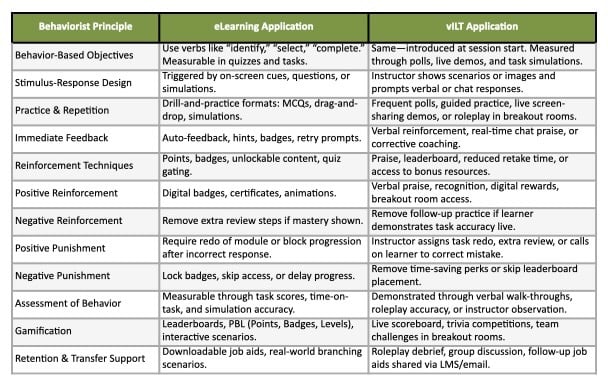

Principle Source: InstrutionalDesign.org-Behaviorism
© 2025 SCM Trainer. Licensed under Creative Commons Attribution-NonCommercial 4.0 International (CC BY-NC 4.0). You may share and adapt this content for non-commercial use with proper attribution.
Learning Models
Mini-Course Design Thoughts
Topic: Utilizing Artificial Intelligence to Optimize the Supply Chain
Issues in many Supply Chains: In supply chain operations, the lack of data-driven decision-making often results from a less-than-full grasp of understanding and using AI technologies effectively.
Even though we have a wealth of data and innovative AI tools at our fingertips, many supply chains continue to depend on traditional static rules, historical averages, and spreadsheet models for essential decisions like demand forecasting, inventory management, route planning, and evaluating supplier risk. This often results in inefficiencies, delayed responses, and missed opportunities for optimization.
Potential issues and Knowledge Gaps:
Limited understanding of AI concepts and terminology
Inability to identify AI use cases across supply chain functions
Lack of skills in interpreting AI-generated insights
Weak collaboration between supply chain and data/tech teams
Poor data literacy and low confidence in data-driven decision-making
Lack of experience applying AI to optimize end-to-end supply chain performance.
Introduction, History, Ethics, Accessibility, & Artifical Intelligence


Instagram Source: ChatGPT from OpenAI
© 2025 SCM Trainer. This work is licensed under a Creative Commons Attribution-NonCommercial 4.0 International License.
Example of Specific Core Gaps:
Many supply chain professionals are unaware of the AI tools in their systems and how to utilize them for daily operations.
Awareness Gap: Many professionals are unaware of the AI tools already available to them.
Application Gap: Even when AI is available, people are unsure how to actually use it to improve forecasting, inventory management, logistics, or supplier decisions.
Confidence Gap: There is hesitation to trust AI insights over traditional methods, such as spreadsheets, experience, or gut feeling.
Skills Gap: Professionals frequently lack the practical skills necessary to interpret AI-driven dashboards and take action.
Identifying viable artificial intelligence applications throughout the supply chain. Today’s supply chains have endless opportunities to apply AI, but significant gaps are holding teams back:
Awareness Gap: Many professionals are not familiar with the practical applications of AI in various supply chain functions, including planning, sourcing, manufacturing, delivering, and managing returns.
Application Gap: Even when they know AI exists, it’s not always obvious how to link the technology to solving everyday supply chain problems.
Confidence Gap: There is uncertainty about identifying the right AI opportunities and a fear of suggesting the wrong fit.
Skills Gap: Many supply chain teams haven’t developed the capability to identify, assess, and prioritize AI use cases that provide tangible value.text here...
© 2025 SCM Trainer. This work is licensed under a Creative Commons Attribution-NonCommercial 4.0 International License.


Additional Note on Audience Context
The learners come from diverse industries and belong to global supply chain organizations. Although their company sizes, regions, and products may differ, they share a common foundation in core supply chain processes — Plan, Source, Make, Deliver, and Enable — making this process-based focus highly relevant and universally applicable.
Process Focus
Plan Professionals:
Focus - Forecasting demand, aligning supply and demand, and analyzing supply chain data for planning.
Role - Demand Planners - Supply Chain Analysts - S&OP Coordinators - Forecasting demand - Aligning supply and demand - Analyzing supply chain data
Source Professionals:
Focus - Sourcing materials, evaluating supplier risk, and managing supplier partnerships with data-driven insights.
Role - Procurement Specialists - Supplier Relationship Managers - Category Managers
- Sourcing materials - Evaluating supplier risk - Managing supplier partnerships
Make Professionals:
Focus - Optimizing production scheduling, quality monitoring, and applying predictive maintenance through AI-driven tools.
Role - Production Planners - Manufacturing Supervisors - Quality Assurance Managers - Production scheduling - Quality monitoring - Predictive maintenance using AI
Delivery / Returns Professionals:
Focus - Route optimization, warehouse operations efficiency, inventory visibility, delivery and returns reliability using AI insights.
Role - Logistics Coordinators - Warehouse Managers - Transportation Managers - Returns Managers - Route optimization - Warehouse efficiency - Delivery reliability
Enable Professionals:
Focus - Driving Operational Excellence, Supporting digital transformation initiatives, implementing AI-enabled tools, ensuring compliance, and enhancing system adoption.
Role - Supply Chain Technology Analysts - Compliance Specialists - Process Improvement Leads - Cross-Functional and Enterprise Managers and Directors - Supply Chain Project Managers - Supply Chain Data Analysts - Site Managers


© 2025 SCM Trainer. This work is licensed under a Creative Commons Attribution-NonCommercial 4.0 International License.
ADDIE Design Model
Utilizing Artificial Intelligence for Data-Driven Decision-Making in Supply Chain Operations
Demographics
Age Range: 30–50 years old
Career Level: Mid-level supply chain professionals (e.g., Supply Chain Analysts, Demand Planners, Inventory Managers, Logistics Supervisors)
Education: Bachelor’s degree or higher, typically in Business, Engineering, Supply Chain Management, or a related field
Geography: Global audience, with learners primarily located in the Americas, Europe, the Middle East, and the Asia-Pacific regions
Language: Many are proficient in English and may speak English as a second language. Note: Arabic translation will be available within 90 days of course launch, followed by Latin American Spanish translation within 120 days.
Background and Prior Knowledge
Familiar with foundational supply chain concepts such as inventory management, forecasting, procurement, and logistics.
Has hands-on experience with ERP or supply chain software (e.g., SAP, Oracle, or JDA/Blue Yonder).
Limited to moderate exposure to AI tools, data visualization platforms (e.g., Power BI, Tableau), or advanced analytics.
Has heard of machine learning or AI applications but lacks confidence in interpreting or applying AI-driven insights.
© 2025 SCM Trainer. This work is licensed under a Creative Commons Attribution-NonCommercial 4.0 International License.
ADDIE Design Model
Utilizing Artificial Intelligence for Data-Driven Decision-Making in Supply Chain Operations
Skills and Dispositions
Analytical mindset: Learners are used to working with data and spreadsheets, but want to upgrade from descriptive reporting to predictive and prescriptive insights
Tech-curious but not tech-savvy: Willing to adopt new tools, but may be intimidated by complex AI terminology or software interfaces
Action-oriented: Interested in applying what they learn directly to on-the-job challenges (e.g., improving forecast accuracy, reducing stockouts, optimizing transportation)
Problem-solvers: Motivated by efficiency, cost savings, and operational excellence
Skeptical of AI hype: Require clear, real-world applications to build trust in AI capabilities
Additional Considerations
Mid-level managers who lack sufficient experience or competence should consider an essential supply chain management skills course before attending this mini-course.
Likely juggling multiple responsibilities, so they need short, focused modules (35 minutes or less)
Value interactivity, practical examples, and scenario-based learning over theory
May need flexibility in accessing content across devices (desktop, tablet, mobile)
© 2025 SCM Trainer. This work is licensed under a Creative Commons Attribution-NonCommercial 4.0 International License.
Methods to assess learner baseline data skills


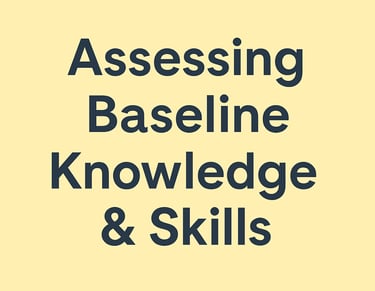

When designing my mini-course, I take a thoughtful approach to understanding learners at three important stages: before, during, and after the course.
Before the course begins, I make it a point to evaluate their baseline skills and understanding using friendly self-assessments, engaging knowledge quizzes, or scenario-based diagnostics.
During the course, I love to use quick polls, interactive knowledge checks, and hands-on activities to keep track of students' progress and adjust their learning journey as needed.
After the course concludes, I gather valuable feedback and assess knowledge gains through enjoyable post-course quizzes or reflection activities.
These methods help create a learning experience that is both focused and effective. I'm excited to keep using and refining these approaches in the design of my mini-course!
© 2025 SCM Trainer. This work is licensed under a Creative Commons Attribution-NonCommercial 4.0 International License.
Methods to build trust and reduce intimidation

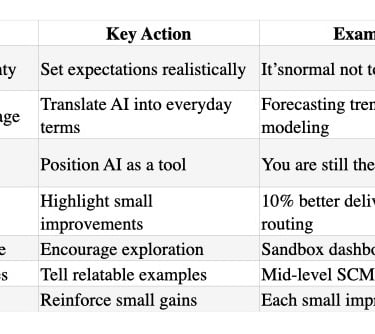


© 2025 SCM Trainer. This work is licensed under a Creative Commons Attribution-NonCommercial 4.0 International License.
WriteBuilding trust and confidence is a journey that starts even before the course begins! I love designing engaging interactions right from the get-go—like self-assessments, welcome surveys, and early discussion prompts—to help learners feel comfy and connected.
Throughout the course, I focus on serving up small, manageable bites of information so that learners can celebrate early victories in grasping and using AI.
The emphasis is on less theory and more hands-on application, with demonstrations, guided walkthroughs, and fun practice opportunities that help build skills and confidence step by step.
By fostering a warm and supportive atmosphere, and celebrating those practical wins, learners quickly recognize the incredible value of AI and gather the momentum they need for success!
Dick and Carey Design Model
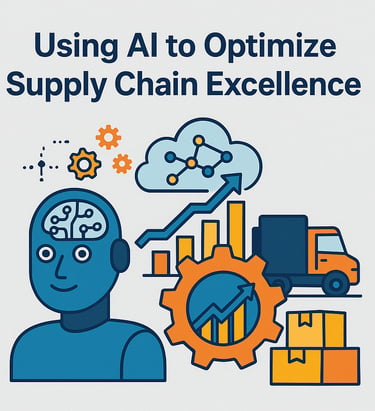

For my mini-course " Using AI to Optimize Your Supply Chain Operational Excellence, " I've created an engaging e-learning experience! This format offers flexible, self-paced learning for mid-level supply chain professionals navigating different global time zones. Given the fast-paced changes in AI tools and practices, eLearning makes it easier to update content promptly, ensuring you always have access to the most relevant information. With its asynchronous structure, you can revisit content whenever you need, which is super helpful for grasping the complex and ever-evolving topics like AI-driven analytics, forecasting, and optimization.
Alternatively, the mini-course can be offered as an engaging instructor-led session, either virtually or in person. This format is perfect for organizations looking for real-time interaction, lively Q&A sessions, or facilitated discussions. The instructor-led version beautifully complements the eLearning option by providing deeper insights into practical use cases or live demonstrations of AI-enabled supply chain planning and optimization tools.
Furthermore, creating a shorter executive version of the course could help offer a high-level overview of the topic. It would focus on the essential aspects like return on investment (ROI), implementation strategy, and organizational impact. Introducing this executive track can enhance awareness and garner support among senior leadership. This way, mid-level managers who complete the full mini-course will have the executive sponsorship and resources to confidently and swiftly apply their new knowledge and skills in their workplace. text here...
© 2025 SCM Trainer. This work is licensed under a Creative Commons Attribution-NonCommercial 4.0 International License.
The chosen approach for this mini-course is asynchronous online learning (eLearning)! This format is perfect for our target audience—mid-level supply chain professionals—all around the globe, from the Americas to Europe, the Middle East, and Asia-Pacific. With asynchronous eLearning, everyone can dive into the material at a time that works best for them, no matter their time zone or busy schedules.
This course offers a flexible 3–4 hour learning experience with 3 to 5 engaging modules, each lasting around 35 minutes or less. This thoughtful design makes it easy for busy professionals to tackle a module in one sitting, letting them smoothly return to their daily supply chain tasks without interruptions. Plus, it allows learners to pause and pick up where they left off whenever they choose, making it especially useful in fast-paced and time-sensitive supply chain settings.
This approach encourages independence, caters to various learning speeds, and makes it easier to expand globally while also streamlining the process of maintaining and updating content—something that's particularly important as we see the fast-paced growth of AI in supply chain operations.


© 2025 SCM Trainer. This work is licensed under a Creative Commons Attribution-NonCommercial 4.0 International License.
Understanding by Design (UbD)
Mini-Course: “Using AI to Obtain Supply Chain Operational Excellence”
By the end of this course, learners will be able to:
Identify essential supply chain functions where artificial intelligence can enhance performance and efficiency.
Explain the differences between traditional and AI-driven methods in forecasting, inventory optimization, and logistics decision-making.
Examine operational data sets to uncover inefficiencies and opportunities for AI implementation throughout the supply chain.
Evaluate various AI technologies (e.g., machine learning, predictive analytics, robotic process automation) for their applicability in specific supply chain scenarios.
Create a strategic roadmap for integrating AI tools into supply chain processes (e.g., demand planning, warehouse management).
Develop a business case demonstrating the ROI potential of AI applications in supply chain optimization.
Interpret key performance indicators (KPIs) such as forecast accuracy, inventory turnover, and service level to assess the impact of AI interventions.
Effectively communicate AI-driven insights and recommendations to both technical and non-technical stakeholders.
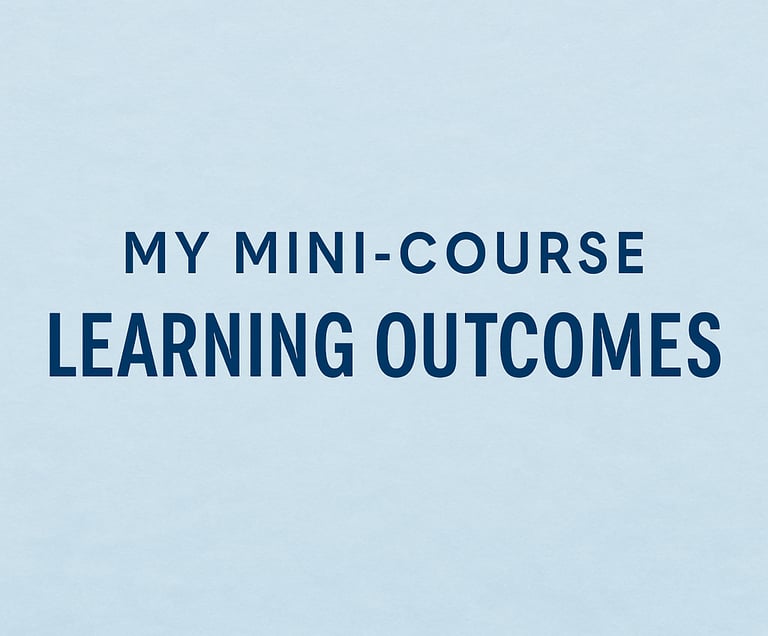

© 2025 SCM Trainer. This work is licensed under a Creative Commons Attribution-NonCommercial 4.0 International License.
Rapid Instructional Design Approach
A list of six potential learning activities for my minicourse “Using AI to Achieve Supply Chain Operational Excellence,” aligned with the draft course learning outcomes (CLOs):
1. AI-Powered Decision Case Study
Overview: Learners will analyze a real-world supply chain scenario where AI was implemented to resolve a bottleneck or inefficiency (e.g., demand forecasting or inventory allocation). They will identify the problem, assess the AI intervention, and critique the outcome.
Aligned CLO(s): CLO1 – Evaluate how AI supports supply chain decision-making; CLO4 – Interpret AI-driven insights for supply chain optimization.
2. Interactive Tool Exploration
Overview: Learners will participate in an interactive walkthrough or sandbox simulation of a common AI tool (like a demand planning engine or routing algorithm). They will test basic inputs and observe how the AI model makes decisions based on real-time data.
Aligned CLO(s): CLO2 – Explore key AI tools and techniques relevant to supply chain applications.
3. Supply Chain AI Readiness Checklist
Overview: In this reflective activity, learners complete a guided AI readiness assessment of their own (or a sample) organization. They will evaluate factors such as data infrastructure, skills, and stakeholder alignment for AI adoption.
Aligned CLO(s): CLO3 – Assess the organizational factors necessary for successful AI integration.


© 2025 SCM Trainer. This work is licensed under a Creative Commons Attribution-NonCommercial 4.0 International License.
Write 4. Micro Video Analysis + Poll
Overview: Learners watch a brief expert interview or explainer video about an AI technique (e.g., machine learning in inventory optimization), followed by an embedded poll with reflection prompts to relate the concept to their current role.
Aligned CLO(s): CLO2 – Explore key AI tools and techniques; CLO5 – Reflect on opportunities to apply AI in learners’ specific supply chain context.
5. Peer Discussion Forum: AI Success & Cautionary Tales
Overview: Learners will contribute to a discussion forum by providing one example each of a successful and a failed AI implementation in the supply chain. They will evaluate the critical factors that led to each outcome, drawing from readings and personal experience.
Aligned CLO(s): CLO1 – Evaluate AI’s impact; CLO3 – Assess readiness for AI integration; CLO5 – Reflect on opportunities for AI in practice.
6. End-of-Module AI Application Plan
Overview: Learners draft a concise AI Application Plan that summarizes how they would apply an AI technique to a specific supply chain challenge in their workplace. This plan synthesizes course insights and prepares learners to advocate for the use of AI.
Aligned CLO(s): CLO4 – Interpret AI-driven insights; CLO5 – Reflect on and plan for practical AI applications. text here. Reflect on and plan for practical AI applications.
© 2025 SCM Trainer. This work is licensed under a Creative Commons Attribution-NonCommercial 4.0 International License.
In creating my minicourse, “Using AI to Drive Operational Excellence in the Supply Chain,” I’ve found that the Successive Approximation Model (SAM) is an excellent fit. This model’s iterative and collaborative nature and its focus on feedback work perfectly with our topic's lively and ever-changing landscape, making it just right for mid-level supply chain professionals.
Why SAM Is a Strong Fit:
Iterative prototyping allows us to swiftly craft and refine interactive eLearning modules, which is ideal for enhancing scenario-based activities that mirror real-world AI decision-making.
Involving stakeholders and SMEs from the start fosters alignment with technical accuracy and enhances the professional relevance throughout the various supply chain functions, such as Plan, Source, Make, and Deliver.
Ongoing feedback loops support quick replies to learner input, which is crucial when exploring new technologies like artificial intelligence in supply chain applications.
© 2025 SCM Trainer. This work is licensed under a Creative Commons Attribution-NonCommercial 4.0 International License.
Alternative/Complementary Approaches Considered:
While SAM is the primary model, I also recognize the value in selectively integrating elements of:
Understanding by Design (UbD) is an excellent approach that helps us think backwards about learning, starting with the outcomes we truly want to achieve (for example, “Learners will be able to apply AI tools to real-world logistics problems”).
Rapid Instructional Design (RID) makes it possible to create smaller, focused learning objects quickly, perfectly aligning with the minicourse format.
My Final Recommendation:
The SAM model and backward design thinking (UbD) for clear assessments and outcomes create a flexible and purposeful framework. This blended approach ensures both efficiency and instructional quality, which are essential for crafting a 3–4 hour, modular eLearning course on exciting new areas like AI in supply chain operations.
© 2025 SCM Trainer. This work is licensed under a Creative Commons Attribution-NonCommercial 4.0 International License.
Learning Objectives, Bloom's Taxonomy, and SME
Course Learning Outcomes (CLOs)
Mini-course title: Using AI to Obtain Supply Chain Operational Excellence
Explain the key concepts of artificial intelligence (AI) and their significance to supply chain management.
Analyze current supply chain challenges and identify opportunities where AI can drive operational excellence.
Evaluate AI-enabled tools and technologies for their ability to enhance specific supply chain functions (e.g., forecasting, inventory, logistics, procurement).
Apply AI use cases to optimize key areas within the supply chain using real-world business scenarios.
Design a feasible improvement plan that incorporates AI into the current supply chain process to enhance efficiency, agility, or resilience.
Assess the risks, limitations, and ethical considerations of deploying AI in supply chain operations.
Note:
• Each CLO builds progressively from foundational knowledge to applied strategic thinking and design.
• These outcomes align with Bloom’s levels from Understand to Create.
• The outcomes provide a strong framework for measurable module-level learning objectives (MLOs) and project-based assessments.
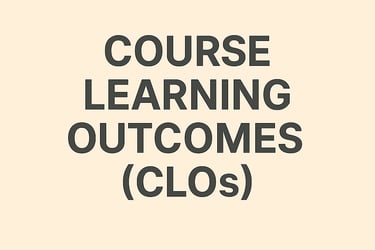

© 2025 SCM Trainer. This work is licensed under a Creative Commons Attribution-NonCommercial 4.0 International License.
Module Learning Objectives (MLOs)
By the end of this module, learners will be able to:
1. Identify common inventory-related challenges (e.g., stockouts, excess inventory, demand variability) that AI can help mitigate. Aligns with CLO 2: Analyze current supply chain challenges and identify opportunities where AI can drive operational excellence.
2. Describe how AI technologies such as machine learning and predictive analytics are applied to inventory forecasting and optimization. Aligns with CLO 1: Explain the core concepts of artificial intelligence (AI) and their relevance to supply chain management.
3. Compare traditional inventory management methods with AI-enabled approaches in terms of accuracy, responsiveness, and cost efficiency. Aligns with CLO 3: Evaluate AI-enabled tools and technologies for their ability to enhance specific supply chain functions.
4. Evaluate a sample AI inventory tool or dashboard and assess its capabilities for improving safety stock levels and reducing carrying costs. Aligns with CLO 3: Evaluate AI-enabled tools and technologies
5. Apply AI-driven inventory insights to a real-world supply chain scenario to improve stock replenishment planning. Aligns with CLO 4: Apply AI use cases to optimize key areas within the supply chain.
6. Summarize the risks and limitations associated with relying on AI in inventory decision-making (e.g., data bias, system dependency). Aligns with CLO 6: Assess the risks, limitations, and ethical considerations.
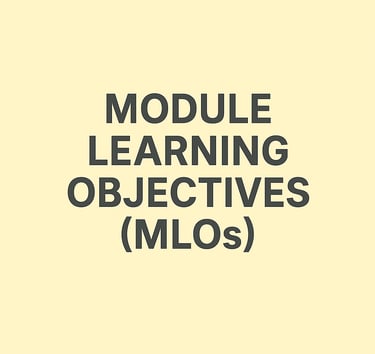

© 2025 SCM Trainer. This work is licensed under a Creative Commons Attribution-NonCommercial 4.0 International License.
Mini-Course Subject Matter Experts
Jeffrey McDaniels
Role: Lead SME, Chief Instructor, and Instructional Designer
Credentials:
APICS Fellow and Master Instructor
Lean Six Sigma Master Black Belt (LSSMBB)
Certified in PMP and CPSM
CEO & Chief Learning Architect at SCM Trainer
David Thoma
Role: 2nd SME
Senior Instructor, SCM Trainer
Credentials:
SCM Practitioner, APICS Fellow, and Master Instructor


© 2025 SCM Trainer. This work is licensed under a Creative Commons Attribution-NonCommercial 4.0 International License.
Resources to Review before developing my Mini-Course
Blockchain, IoT, and AI Technologies for Supply Chain Management: Apply Emerging Technologies to Address and Improve Supply Chain Management. (2024).
Townson, S. (2021, December). 3 Areas Where AI Will Boost Your Competitive Advantage. Harvard Business Review.
Beadle, R. (2025, April). AI: The Key to Navigating Supply Chain Challenges in an Uncertain World. Supply Chain Management Review.
Clowes, C. (2024, June). 6 Key Challenges in AI Implementation for the Supply Chain Industry. Supply Chain: Beyond the Hype.
ASCM. Supply Chain Technology Certificate.
ASCM. Certified in Transformation for Supply Chain (CTSC).


© 2025 SCM Trainer. This work is licensed under a Creative Commons Attribution-NonCommercial 4.0 International License.
© 2025 SCM Trainer. This work is licensed under a Creative Commons Attribution-NonCommercial 4.0 International License.
My Top 10 Takeaways and Reflections
1. Prioritize comprehensive sourcing by gathering a balanced mix of books, peer-reviewed articles, credible blogs, podcasts, and templates to enhance research and practical application.
2. Instructional Design Models provide a Roadmap - Utilize frameworks such as ADDIE, SAM, Dick and Carey, and UbD to structure the development of goal-aligned, learner-centered courses.
3. Match Models to Project Needs - Different models excel in various scenarios—structured (ADDIE), iterative (SAM), systems-driven (Dick and Carey), or outcome-focused (UbD).
4. Backward Design Sharpens Focus - Starting with end goals ensures that all learning activities and assessments support real-world transfer and application.
5. Learning Objectives Anchor Design - Clear and measurable objectives aligned with Bloom’s Taxonomy guide content development, activity selection, and assessment creation.
6. Models Are Guides, Not Constraints - Models should guide structure without limiting creativity; blending models often results in better project outcomes.
7. Evaluation Is Continuous and Essential - Both formative and summative evaluations are crucial for ensuring course effectiveness and offering data for ongoing improvements.
8. Learner analysis is foundational - A deep understanding of learners' needs, motivations, and contexts leads to higher engagement and better learning outcomes.
9. Assessment Must Align Directly with Objectives - Effective assessment strategies measure precisely what the learning objectives specify, ensuring validity, reliability, and real skill transfer.
10. Reflection and Adaptation Build Expertise - Continual reflection and a willingness to adapt design models strengthen instructional design skills over time.


Sequencing, Assessments, & Alignment
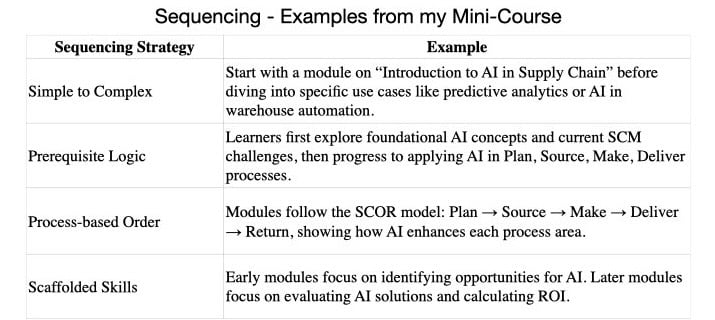



© 2025 SCM Trainer. This work is licensed under a Creative Commons Attribution-NonCommercial 4.0 International License.
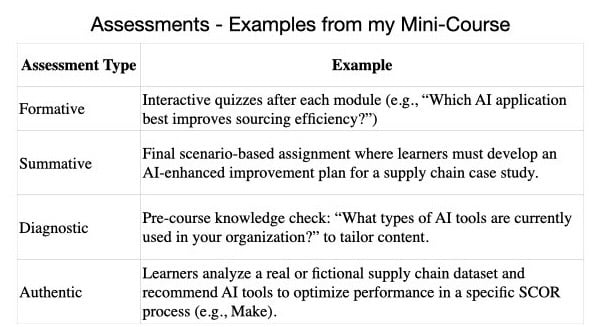



© 2025 SCM Trainer. This work is licensed under a Creative Commons Attribution-NonCommercial 4.0 International License.
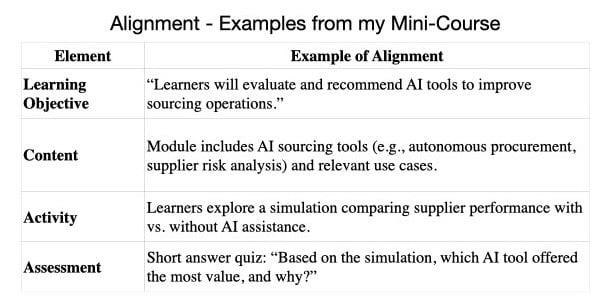



© 2025 SCM Trainer. This work is licensed under a Creative Commons Attribution-NonCommercial 4.0 International License.
Digital Media, Digital Tools, and Technology
Digital Media
Completed checklist - Pathway to Supply Chain Excellence
Basic Information
Evaluator Name: Jeffrey McDaniels
Date of Evaluation: May 20, 2025
Title of Resource: Pathways to Supply Chain Excellence
Resource URL: https://directory.doabooks.org/handle/20.500.12854/65825
Media Format: ☐ Video ☐ Audio ☐ Interactive ☐ Infographic ☐ Document ☐ Simulation ☐ Other: ______
License Type: ☐ CC BY ☐ CC BY-SA ☐ CC BY-NC ☐ CC BY-NC-SA ☐ CC BY-ND ☐ CC0 ☐ Public Domain ☐ All Rights Reserved
Open License Verified? ☐ Yes ☐ No
Instructional Relevance & Alignment
☐ Aligned with one or more learning objectives? YES
☐ Connects clearly to the course/module topic? YES
☐ Supports your instructional strategy (e.g., UbD, UDL, Andragogy)? YES
☐ Culturally inclusive and globally relevant? YES
☐ Is the language appropriate for the audience (plain language, jargon-free)? YES
☐ Bias-free and balanced in perspective? YES
Cognitive Learning Design (Mayer’s Principles)
☐ Does it apply coherence (excludes extraneous info)? YES
☐ Uses signaling to direct attention to key points? NO
☐ Combines audio and visuals effectively (modality)? NO
☐ Text and graphics aligned spatially and temporally? NO
☐ Is the content segmented or chunked for learner control? YES
Summary: Strong cognitive structure for reading; would benefit from instructional adaptation with Mayer-based visuals and interactive segments.
Accessibility & ADA Compliance
☐Closed captions or transcripts available for media? NO
☐ Text alternatives provided for visuals and charts? NO
☐ Compatible with screen readers? YES
☐ Available in multiple formats (HTML, PDF, mobile-ready)? NO
☐ Does it meet WCAG 2.1 or ADA standards? NO
Usability & Instructional Quality
☐ Interactivity encourages participation or feedback? NO
☐ Is the resource error-free (spelling, grammar, data)? YES
☐ Visually clear and logically organized? YES
☐ Does audio/video quality meet professional standards? YES
☐ Is navigation intuitive and user-friendly? NO
Reuse, Technical, & Sustainability Factors
☐ Can it be reused or adapted under its license terms? YES
☐ LMS-compatible (SCORM, HTML5, or link embedding)? NO
☐ Hosted on a reliable platform (not likely to disappear)? YES
☐ Likely to be updated or maintained regularly? YES
☐ No proprietary plug-ins or special software needed? YES
Privacy & Data Security (For Interactive Tools)
☐ No tracking or data collection without disclosure? YES
☐ Complies with FERPA/GDPR/privacy policies (if applicable)? YES
☐External links or embeds reviewed for content integrity? YES
Instructor Support & Pedagogical Value
☐ Includes instructor guides or support materials? YES
☐ Offers opportunities to differentiate learning (e.g., UDL)? NO
☐ Content reviewed or rated by other educators? YES
☐ Supports the development of core competencies or skills? YES
Evaluator Summary / Recommendation
This open-access article is a strong foundational resource for advanced topics in financial-physical integration in supply chain planning. It best reads with instructor-led discussion, interactive infographic add-ons, and scenario-based application questions. It is too general and strategic in focus; however, some use of segments may be acceptable with some modifications.
Final Decision
Use in Course? ☐ Yes – As Is ☐ Yes – With Modifications ☐ No – Not Recommended


© 2025 SCM Trainer. Licensed under Creative Commons Attribution-NonCommercial 4.0 International (CC BY-NC 4.0). You may share and adapt this content for non-commercial use with proper attribution.
Visual Design
Digital Media Checklist - Updated
Digital Media Evaluation Checklist
Basic Information
Evaluator Name: Jeffrey McDaniels
Date of Evaluation: June 3, 2025 (updated from previous version)
Title of Resource: Using AI to Obtain Supply Chain Operational Excellence (SCM Trainer eLearning Mini-Course
Resource URL: https:
Media Format: ☐ Video ☐ Audio ☐ Interactive ☐ Infographic ☐ Document ☐ Simulation ☐ Other: ______
License Type: ☐ CC BY ☐ CC BY-SA ☐ CC BY-NC ☐ CC BY-NC-SA ☐ CC BY-ND ☐ CC0 ☐ Public Domain ☐ All Rights Reserved
Open License Verified? ☐ Yes ☐ No
Instructional Relevance & Alignment
☐ Aligned with one or more learning objectives? YES
☐ Connects clearly to the course/module topic? YES
☐ Supports your instructional strategy (e.g., UbD, UDL, Andragogy)? YES
☐ Culturally inclusive and globally relevant? YES
☐ Is the language appropriate for the audience (plain language, jargon-free)? YES
☐ Bias-free and balanced in perspective? TBD
Cognitive Learning Design (Mayer’s Principles)
☐ Does it apply coherence (excludes extraneous info)? YES
Uses signaling to direct attention to key points? YES
Combines audio and visuals effectively (modality)? YES
Text and graphics aligned spatially and temporally? YES
Is the content segmented or chunked for learner control? YES
& ADA Compliance
☐ Closed captions or transcripts available for media? YES
☐ Text alternatives provided for visuals and charts? YES
☐ Compatible with screen readers? TBD
☐ Available in multiple formats (HTML, PDF, mobile-ready)? YES
☐ Does it meet WCAG 2.1 or ADA standards? YES
Usability & Instructional Quality
☐ Interactivity encourages participation or feedback?
☐ Is the resource error-free (spelling, grammar, data)?
☐ Visually clear and logically organized?
☐ Does audio/video quality meet professional standards?
☐ Is navigation intuitive and user-friendly?
Reuse, Technical, & Sustainability Factors
☐ Can it be reused or adapted under its license terms?
☐ LMS-compatible (SCORM, HTML5, or link embedding)?
☐ Hosted on a reliable platform (not likely to disappear)?
☐ Likely to be updated or maintained regularly?
☐ No proprietary plug-ins or special software needed?
Privacy & Data Security (For Interactive Tools)
☐ No tracking or data collection without disclosure? -
☐ Complies with FERPA/GDPR/privacy policies (if applicable)?
☐External links or embeds reviewed for content integrity?
Instructor Support & Pedagogical Value
☐ Includes instructor guides or support materials?
☐ Offers opportunities to differentiate learning (e.g., UDL)?
☐ Content reviewed or rated by other educators?
☐ Supports the development of core competencies or skills?
Evaluator Summary / Recommendation
The course is under development, so the checklist is only partially complete. As we progress through the course, I will review and update it to include TBD areas. More development and evaluation to come.
Final Decision
Use in Course? ☐ Yes – As Is ☐ Yes – With Modifications ☐ No – Not Recommended
© 2025 SCM Trainer. This work is licensed under a Creative Commons Attribution-NonCommercial 4.0 International License.


Audio File
Audio File tools used: Speechify Studio (voice-overs), and, Iframely (embed code generation).
Audio introduction to my eLearning Mini-Course (mp3 file, 58sec)
Key Takeaways of0end of Module 1 Summary (mp3 file, 53sec)
© 2025 SCM Trainer. This work is licensed under a Creative Commons Attribution-NonCommercial 4.0 International License.
© 2025 SCM Trainer. This work is licensed under a Creative Commons Attribution-NonCommercial 4.0 International License.
Learning Objectives/Module it Supports
(Supports CO2, CO4, CO7, and CO8)
This week's digital document assignment supports multiple objectives from my micro-course, Using AI to Obtain Supply Chain Operational Excellence. I created three visuals:
An infographic titled "How AI Improves Forecasting, Inventory, and Logistics",
A job aid called "AI Tool Match Guide: What to Use for Each Supply Chain Problem", and
A quick reference sheet is titled "Top 5 KPIs for Evaluating AI Impact in Supply Chains."
These materials support CO2 by differentiating traditional vs. AI-enhanced methods, CO4 by aligning AI technologies to operational use cases, and CO7 by clarifying how to evaluate AI's impact through KPIs. I also recorded and embedded an audio description of the infographic to support accessibility, directly aligning with CO8 and reinforcing UDL principles.
Digital Images
DropBox Link for copy: Digital Media Evaluation Checklist
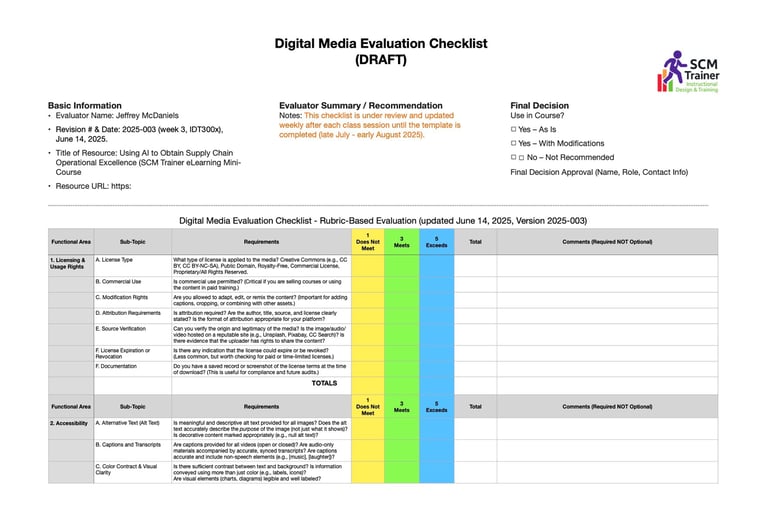

© 2025 SCM Trainer. Licensed under Creative Commons Attribution-NonCommercial 4.0 International (CC BY-NC 4.0). You may share and adapt this content for non-commercial use with proper attribution.
DropBox Link for copy: Image File
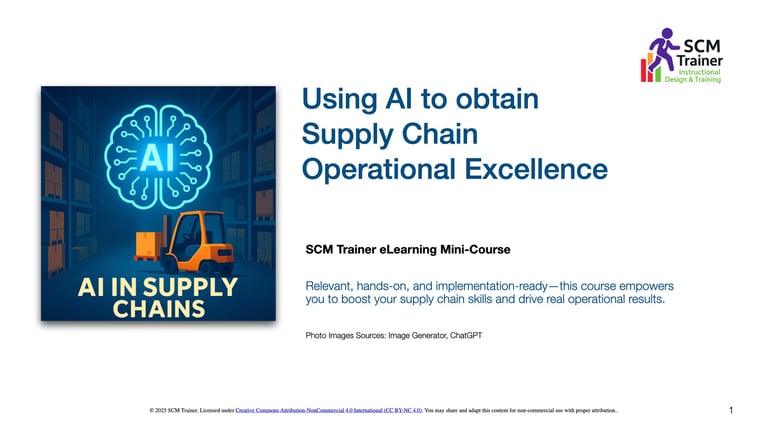

© 2025 SCM Trainer. Licensed under Creative Commons Attribution-NonCommercial 4.0 International (CC BY-NC 4.0). You may share and adapt this content for non-commercial use with proper attribution.
© 2025 SCM Trainer. Licensed under Creative Commons Attribution-NonCommercial 4.0 International (CC BY-NC 4.0). You may share and adapt this content for non-commercial use with proper attribution.
Title: Using AI to Achieve Operational Excellence
Version: 6
Date: July 3, 2025
YouTube Link: https://youtu.be/W1y52S5z4Wo
Tag: iMovie
Format: Video & Audio
Resolution: 1080P
Frame Rate: 60 FPS
Quality: High
Compress: Faster
Tools: Keynote - Speechify Studio - iMovie - YouTube

Digital Images - Animation
© 2025 SCM Trainer. Licensed under Creative Commons Attribution-NonCommercial 4.0 International (CC BY-NC 4.0). You may share and adapt this content for non-commercial use with proper attribution.
Storyboards
Articulate 360 AI-Compatible Storyboard
Using AI to Obtain Operational Excellence – Introduction Module
This storyboard is designed to be compatible with Articulate 360 AI course authoring. Each slide features layout elements, narration, interactions, and media suggestions. Use this format to import into Rise or Storyline, or to copy and paste into Rise AI slide generators.
Slide 1: Welcome to the Course
Layout: Full-width introduction section with instructor photo or avatar
Narration: Welcome. I’m Jeffrey McDaniels—supply chain management instructor and practitioner. This course is designed to help you apply AI practically—right now—to solve real operational problems.
On-Screen Text: Welcome to Using AI to Drive Operational Excellence
Interaction: Button to start the module or open the instructor bio popup
Slide 2: Why Is It Urgent?
Layout: Two-column layout with an image (rocket launch) and accompanying text.
Narration: AI may seem futuristic, but it’s already being used—and making a real impact across supply chains.
On-Screen Text: Why this course, why now?
Interaction: Animated keyword reveal: Smarter, Faster, Resilient
Slide 3: Supply Chain Challenges We All Know
Layout: Split image with labeled icons and brief descriptions
Narration: Unreliable forecasts, supplier delays, and logistics issues… sound familiar?
On-Screen Text: What’s Holding You Back?
Interaction: Hotspot activity — Click icons to reveal problem descriptions.
Slide 4: Reflection Activity – Your Operational Gap
Layout: Question block with a single text entry
Narration:
On-Screen Text: What’s one area in your operation where making better decisions could improve performance?
Interaction: Text field for learner responses (optional voice reflection)
Slide 5: The AI Advantage
Layout: Icon grid with brief caption text
Narration: AI can analyze data more quickly, suggest next steps, and identify issues before they interrupt operations.
On-Screen Text: Smarter | Faster | More Resilient
Interaction: Click to reveal examples for each AI benefit
Slide 6: What This Course Will Cover
Layout: Four-square icon grid with labels and introductory text.
Narration: This course skips the theory and goes directly into practical AI applications that matter today.
On-Screen Text: Forecasting | Supplier Risk | Logistics | Performance
Interaction: Click each icon to view a brief preview of the module topic.
Slide 7: What You’ll Be Able to Do
Layout: Checklist format with animated check marks.
Narration: By the end, you’ll be able to evaluate AI tools, reduce forecast errors, optimize logistics, and communicate the impact.
On-Screen Text: Course Outcomes
Interaction: Display list with each outcome aligned to a course objective
Slide 8: Interactive Scenario – Where Would You Start?
Layout: Scenario block with decision branching
Narration:
On-Screen Text: Let’s Try It: Fix the Forecast
Interaction: Choose-your-path format; each option provides feedback on the selected AI solution.
Slide 9: Wrap-Up Reflection
Layout: Short-answer block with icon
Narration:
On-Screen Text: What’s the biggest opportunity for AI in your position?
Interaction: Text entry or optional voice input, plus download reflection.
Slide 10: Get Ready for Module 1
Layout: Tile preview block.
Narration: In the next module, you’ll learn how AI lowers forecast errors—and where to begin.
On-Screen Text: Up Next: AI Forecasting
Interaction: The Continue button links to Module 1
Authoring Tools
IDD - Interactive Module
Interactive Module link:
https://scmtrainer.learnworlds.com/course/opportunities-for-ai-in-logistics
PDF Checklist:
© 2025 SCM Trainer. Licensed under Creative Commons Attribution-NonCommercial 4.0 International (CC BY-NC 4.0). You may share and adapt this content for non-commercial use with proper attribution.
Signature Assignment Document
© 2025 SCM Trainer. Licensed under Creative Commons Attribution-NonCommercial 4.0 International (CC BY-NC 4.0). You may share and adapt this content for non-commercial use with proper attribution.
Course Title: Fixing Forecast Errors with Data
Course Overview
This interactive microlearning course provides mid-level supply chain professionals with the skills to identify, analyze, and correct forecast errors using real-world data. Through 5–6 brief, scenario-based modules, learners explore topics such as bias, variance, trend shifts, and error metrics like MAPE. The course integrates simulations, gamified challenges, and guided reflection to support learners in making better data-driven forecasting decisions.
Knowledge Gap Statement
Mid-level supply chain professionals often lack the practical, data-driven forecasting skills needed to identify and correct forecast errors. While many are familiar with basic forecasting tools (e.g., ERP or Excel), they do not have sufficient exposure to:
Forecast error metrics such as MAPE, MAD, and bias
Root cause analysis techniques for identifying over- or under-forecasting
Scenario-based decision-making that simulates real planning environments
Real-time data interpretation for adjusting forecasts in dynamic market conditions
This gap is not caused by a lack of access to tools but by training that doesn't connect theory with practice. Most existing programs focus too much on tools or ideas, providing few chances to apply forecasting concepts to real-world problems.
Why It Matters:
For the business, this gap leads to inaccurate forecasts, excess inventory, service failures, and misalignment in Sales and Operations Planning (S&OP).
For the learner: It hampers professionals from developing the judgment and confidence necessary to contribute meaningfully to planning discussions and ongoing improvement efforts.
Signature Assignment Document
© 2025 SCM Trainer. Licensed under Creative Commons Attribution-NonCommercial 4.0 International (CC BY-NC 4.0). You may share and adapt this content for non-commercial use with proper attribution.
(Continuation from previous page)
Target Audience & Learner Profile
This course is tailored for mid-level supply chain professionals, particularly those in charge of demand planning and forecast management within the broader supply chain planning function.
Persona Alignment: This audience aligns with the SCM Trainer’s Plan Persona, encompassing roles such as Demand Planner, Supply Chain Analyst, and S&OP Manager. These professionals are responsible for forecasting customer demand, analyzing historical and market data, balancing supply and demand, and supporting key planning processes, such as Sales and Operations Planning (S&OP).
Professional Level: Learners are categorized as mid-level professionals, generally with 3 to 10 years of relevant experience. They work independently in tactical planning roles and are increasingly involved in strategic decision-making. They are developing advanced skills in data analysis, system planning, and cross-functional collaboration.
Skills & Competencies: These learners are proficient in essential planning tools (e.g., Excel, ERP, forecasting modules) but have limited formal training in identifying, analyzing, and fixing forecast errors. They may understand the “what” of forecasting but need structured support to grasp the “why” and “how” behind error diagnostics and resolution.
Disposition: Goal-oriented, tech-savvy, and data-literate. They are highly motivated to quickly apply new skills to enhance accuracy, performance, and confidence in planning. They value concise, relevant learning that seamlessly fits into their daily work.
Global Learner Base: Over the past decade, I’ve taught thousands of supply chain professionals worldwide, including those in the Americas, the Middle East, Europe, and Central Asia, through instructor-led (ILT) and virtual instructor-led (VILT) delivery of globally recognized supply chain certifications and advanced microlearning programs.
Signature Assignment Document
© 2025 SCM Trainer. Licensed under Creative Commons Attribution-NonCommercial 4.0 International (CC BY-NC 4.0). You may share and adapt this content for non-commercial use with proper attribution.
(Continuation from previous page)
Course Type
This course is designed as a problem-based, scenario-driven microlearning experience because forecast error correction is a skill best learned through applied decision-making rather than passive content consumption. Real-world forecasting challenges are complex and contextual, requiring learners to interpret data, identify causes, and take corrective action.
A scenario-based format reflects these real-life conditions and encourages critical thinking, while problem-solving activities help strengthen retention and the transfer of learning. This method aligns with adult learning theory and supports the development of job-related forecasting skills.
Signature Assignment Document
© 2025 SCM Trainer. Licensed under Creative Commons Attribution-NonCommercial 4.0 International (CC BY-NC 4.0). You may share and adapt this content for non-commercial use with proper attribution.
(Continuation from previous page)
Course Modality
This course is offered as a self-paced, online microlearning experience designed to accommodate busy mid-level supply chain professionals seeking flexible and immediately applicable learning.
Why Self-Paced?
Learners can access content at their convenience—perfect for busy professionals managing daily tasks.
It supports personalized pacing, enabling learners to revisit complex concepts (e.g., MAPE calculation) or skip familiar material.
Self-pacing decreases cognitive overload by dividing content into manageable parts, consistent with cognitive load theory.
Why Online?
Forecasting relies on data and digital methods, making online delivery a perfect match for tools, simulations, and dashboards.
Learners are spread worldwide, with many located in North America, Europe, the Middle East, and Central Asia. Conducting in-person sessions would be cost-prohibitive and logistically challenging due to differences in time zones, travel expenses, and scheduling difficulties.
Online delivery ensures scalability and accessibility for global or hybrid teams, eliminating limitations imposed by live session constraints.
Integration with digital tools (e.g., Excel, BI dashboards, ERP simulations) enables learners to practice in environments that mirror their fundamental work tools.
Why Microlearning?
Each module (35–45 minutes) targets a specific skill or concept, such as identifying bias or analyzing trend shifts.
Microlearning aligns with behaviorist reinforcement: learners get quick feedback, complete brief tasks, and remain motivated.
It enhances just-in-time learning—planners can apply what they learn immediately to refine current forecasts.
Summary:
The chosen modality maximizes relevance, flexibility, and engagement—delivering measurable results without disrupting learners’ daily responsibilities. It’s a modality designed for how professionals learn and apply forecasting skills in the real world.
Signature Assignment Document
© 2025 SCM Trainer. Licensed under Creative Commons Attribution-NonCommercial 4.0 International (CC BY-NC 4.0). You may share and adapt this content for non-commercial use with proper attribution.
(Continuation from previous page)
Course Learning Outcomes
(C01) Identify common types of forecast errors (e.g., bias, variance, MAPE) and explain their operational impact on supply chain performance. (Understand)
(C02) Examine historical and real-time demand data to identify the root causes of forecast inaccuracies. (Analyze)
(C03) Apply error metrics such as MAPE, MAD, and Bias to evaluate forecast performance. (Apply)
(C04) Develop corrective forecasting strategies based on data patterns and market signals. (Create)
(C05) Evaluate multiple forecast scenarios to recommend data-driven adjustments that improve planning accuracy. (Evaluate)
(C06) Communicate forecasting insights and recommendations effectively within S&OP or cross-functional planning processes. (Apply/Communicate)
Signature Assignment Document
© 2025 SCM Trainer. Licensed under Creative Commons Attribution-NonCommercial 4.0 International (CC BY-NC 4.0). You may share and adapt this content for non-commercial use with proper attribution.
(Continuation from previous page)
Module/Week/Lesson/Unit Objectives, Learning Activities, Assessment Strategies
Module 3: Identifying Root Causes
Learning Objectives (Linked to CLOs)
Identify internal and external causes of forecast errors, such as promotional effects, weak baselines, and supply disruptions. (Analyze → CLO2)
Analyze demand history and forecast data to identify root causes of over- and under-forecasting. (Analyze → CLO2)
Differentiate between forecast variance due to planning assumptions versus external market signals. (Analyze → CLO5)
Possible Learning Activities
Interactive Dashboard Walkthrough: Learners examine 12 weeks of demand versus forecast data with tooltips highlighting promotions, constraints, and anomalies. LO2, LO3
Scenario-Based Quiz: “What Caused the Spike?”: A branching scenario where learners must identify whether a forecast error was due to internal planning issues or market volatility. LO1, LO2
Error Mapping Activity: Learners complete a drag-and-drop decision tree to trace forecast errors back to possible root causes. LO1, LO2
Reflection Prompt: “What Went Wrong?”: Learners examine a real or hypothetical forecast miss from their organization. LO1, LO3
Possible Assessment Strategies
Data Interpretation Quiz: Learners analyze line charts and variance tables, then respond to questions about possible root causes of errors. LO2, LO3. Auto-graded with feedback.
Root Cause Classification Quiz: Learners classify each error scenario as internal or external from a given set. LO1. Auto-graded, randomized
Decision Tree Completion: An interactive assessment where learners develop a root cause path for a forecast failure scenario. LO2. Interactive/formative.
Short Written Analysis: Learners submit a brief response analyzing the cause of a provided forecast error. LO2, LO3. Instructor-graded with rubric.
Signature Assignment Document
© 2025 SCM Trainer. Licensed under Creative Commons Attribution-NonCommercial 4.0 International (CC BY-NC 4.0). You may share and adapt this content for non-commercial use with proper attribution.
(Continuation from previous page)
Subject Matter Expert/Resources
Jeffrey McDaniels – APICS Master Instructor, Certified Supply Chain Professional, and Instructional Designer. Over a decade of experience delivering global supply chain planning and forecasting education through ILT, VILT, and eLearning.
David Thoma – Supply chain planning and forecasting expert with deep experience in demand planning, forecast diagnostics, and process improvement across multiple industries.
ASCM (APICS) CPIM Certification Course – A globally recognized credential that provides in-depth coverage of demand management, forecasting techniques, error measurement, and supply planning. A key foundational reference for terminology, metrics, and planning frameworks used in this course.
Institute of Business Forecasting & Planning (IBF) – Respected authority in demand planning and forecasting. Provides industry standards, certification programs, benchmarking, and case studies.
Signature Assignment Document
© 2025 SCM Trainer. Licensed under Creative Commons Attribution-NonCommercial 4.0 International (CC BY-NC 4.0). You may share and adapt this content for non-commercial use with proper attribution.
(Continuation from previous page)
Instructional Design Model
Instructional Design Approach: Blended ADDIE + SAM Model
To fix forecast errors with data, I used a blended instructional design model that combines the structure of ADDIE with the flexibility of the Successive Approximation Model (SAM). This hybrid approach creates a results-oriented, learner-focused course that is both scalable and adaptable.
ADDIE: Structured Design Foundation
The ADDIE model offered a strong basis for aligning instructional objectives with business results:
Analyze: Identified the main knowledge gap—professionals lack practical training in forecast error correction and root cause analysis.
Design: Created a modular framework with scenario-based learning, aligned with Bloom’s Taxonomy and real business KPIs.
Develop: Created course assets (simulations, dashboards, assessments) using Articulate Rise, ChatGPT, and Keynote.
Implement: Designed for online delivery via LearnWorlds, supporting asynchronous learning across global teams.
Evaluate: Embedded formative and summative assessments tied to forecast accuracy, with feedback loops for learning reinforcement.
SAM: Agile, Iterative Development
SAM added flexibility and speed to development:
Prototyping: Early versions of key simulations were tested with SMEs and refined based on feedback.
Iteration: Modules 3–6 were improved through design-test-refine loops to enhance realism and interactivity.
Collaboration: Regular SME input helped align scenarios with real planning challenges and learner context.
Why Combine ADDIE and SAM?
The combination of ADDIE’s framework with SAM’s flexibility created a structured yet adaptable design process. It maintained strong learning alignment while allowing quick, feedback-based improvements—perfect for delivering a data-driven, high-impact forecasting course.
Signature Assignment Document
© 2025 SCM Trainer. Licensed under Creative Commons Attribution-NonCommercial 4.0 International (CC BY-NC 4.0). You may share and adapt this content for non-commercial use with proper attribution.
(Continuation from previous page)
Learning Theory
The design of this minicourse is guided by three learning theories—each chosen to support real-world application, learner autonomy, and reinforcement necessary to improve forecast accuracy in supply chain roles.
Experiential Learning (Kolb)
This theory advocates for hands-on, scenario-based learning to mimic real-world planning decisions. Learners participate in forecasting simulations, work with demand data, and consider their choices to improve comprehension and develop judgment. Application: Realistic dashboards, error correction exercises, and guided reflection prompts enhance decision-making skills in context.
Behaviorism
Behaviorist principles, especially reinforcement through feedback and repetition, assist learners in practicing and retaining forecasting skills. Gamified quizzes, performance dashboards, and instant feedback motivate mastery of essential forecasting metrics. Application: Learners earn points, badges, and receive real-time feedback for completing challenges that reinforce the correct use of error metrics and correction strategies.
Adult Learning Theory (Andragogy)
This theory ensures the course respects the learner’s experience, need for autonomy, and preference for practical, job-relevant content. Adults are more motivated when learning is immediately applicable and connected to their current challenges. Application: Learners choose the order of module completion based on personal needs (e.g., “Bias Buster” or “Promo Fixer”) and relate course scenarios directly to their work.
Why a Combined Approach?
Each theory addresses a distinct aspect of the learner experience:
Experiential supports real-world skill development
Behaviorism provides motivation and structure through feedback and rewards
Adult Learning Theory ensures relevance, autonomy, and engagement
Together, they develop a course that is engaging, practical, and performance-driven, helping learners confidently and accurately apply forecasting skills in their roles.
Signature Assignment Document
© 2025 SCM Trainer. Licensed under Creative Commons Attribution-NonCommercial 4.0 International (CC BY-NC 4.0). You may share and adapt this content for non-commercial use with proper attribution.
(Continuation from previous page)
Digital Media Plan (using Keynote, ChatGPT, Speedhify, and Articulate 360)
Interactive Data Dashboards:
Tool: Articulate Storyline or Rise AI Blocks
Purpose: Let learners explore demand vs. forecast data with clickable insights (e.g., bias, promotions, external events).
Application: Modules 2–4
Supports: Experiential Learning – active pattern recognition
Branching Forecasting Scenarios
Tool: Articulate Storyline
Purpose: Learners make forecast decisions and see results based on their choices (e.g., “Fix the Forecast” or “Bias Buster”).
Application: Modules 3, 4, 6
Supports: Experiential + Adult Learning – realistic decision practice
Gamified Quizzes & Challenges
Tool: Articulate Rise (Quiz, Sorting, Fill-in-the-Blank Blocks)
Purpose: Reinforce key forecasting skills like calculating MAPE or identifying trends with points, badges, or feedback.
Application: Modules 2, 4, 5
Supports: Behaviorism – motivation through feedback/reinforcement
AI-Generated Scenario Text & Activities
Tool: ChatGPT
Purpose: Generate realistic demand planning scenarios, quiz distractors, reflection prompts, and error datasets.
Application: Across all modules
Supports: Customization, variation, rapid prototyping
Voice Narration & Audio Reflection Prompts
Tool: Speechify Studio
Purpose: Add dynamic, human-sounding narration to dashboards, introductions, and reflection questions.
Application: Modules 1, 3, 6, 7
Supports: Adult Learning Theory – supports auditory learners and flexible consumption
Learner Reflections (Voice or Text-Based)
Tool: Speechify Studio (Voice Prompt) + Rise AI Journal Block or Text Input
Purpose: Learners reflect on forecasting decisions, supported by voice-guided reflection questions.
Application: End of each core module
Supports: Experiential + Adult Learning – self-assessment and metacognition
Microlearning Video Walkthroughs
Tool: Speechify Studio (voice), Screen Recording + Rise Video Block
Purpose: Narrated walkthroughs of data analysis, forecast evaluation, or error correction examples.
Application: Modules 2–5
Supports: Adult Learning Theory – modeling expert thinking and tools
Downloadable Forecasting Tools
Tool: ChatGPT (template creation), Articulate Rise (Attachment Block)
Purpose: Provide downloadable Excel tools for error tracking, bias analysis, or forecast review templates.
Application: Modules 2, 4, 6
Supports: Transfer to job performance (Adult Learning)
IDD 400x: Evaluation & Capstone Project
Wk1: Microcourse Features & LMS Declaration
Introduction
My name is Jeffrey McDaniels, a supply chain management practitioner, APICS Fellow, and Master Instructor with over two decades of global experience training professionals across the Americas, Europe, and the Middle East.
I am the founder and Chief Instructional Designer at SCM Trainer, a professional development company dedicated to empowering mid-level supply chain professionals through high-quality, scenario-based eLearning, instructor-led certification training, and role-based mentoring. Our courses are designed using modern instructional design best practices and delivered via scalable LMS platforms.
Link to My Instructional Design Document (IDD)
https://www.instructionaldesign.xyz/documents#idd400week1wk1
© 2025 SCM Trainer. Licensed under Creative Commons Attribution-NonCommercial 4.0 International (CC BY-NC 4.0). You may share and adapt this content for non-commercial use with proper attribution.


Wk1: Microcourse Features & LMS Declaration (Continuation)
Minicourse Title: The ABCs of Slotting: Fast, Flexible, and Focused
(This is a supply chain management warehousing microcourse)
A Supply Chain Warehousing Micro Course - This Micro Course serves as a practical introduction to the full Mini Course: “Warehouse Slotting & Pick Optimization in Action.”
Micro Course Overview
Slotting is the hidden force behind warehouse efficiency—but too often, it’s treated as a one-time task rather than a dynamic, demand-driven process. This 10-minute micro course delivers a concise, practical overview of the “ABCs” of warehouse slotting—Analytics-driven, Balanced by flexibility, and Connected to forecasts.
Designed for warehouse professionals, operations leads, and supply chain planners, this course highlights why slotting must be proactive, not reactive.
Duration & Format
Course Type: Micro Course
Duration: ~10 minutes
Includes: Narrated slides, quick scenario, drag-and-drop interaction, knowledge checks
© 2025 SCM Trainer. Licensed under Creative Commons Attribution-NonCommercial 4.0 International (CC BY-NC 4.0). You may share and adapt this content for non-commercial use with proper attribution.


Wk1: Micro course Features & LMS Declaration (Continuation)
Features of My Micro course
1. Scenario-Based Learning Modules
Learners will navigate warehouse-based slotting challenges, applying real-world logic and decision-making frameworks to improve storage efficiency.
2. Interactive Quizzes with Real-Time Feedback
Knowledge checks after each module will include drag-and-drop, matching, and multiple-choice formats using SCORM-compliant activities developed in Articulate Rise.
3. Multimedia Presentations with Professional Voiceover
Key content will be delivered using short-form videos with branded visuals, narration from Speechify Studio, and on-screen highlights.
4. Downloadable Job Aids and Readings
Each module will include optional resources such as infographics, ABC classification guides, and slotting audit templates for workplace application.
Additional supporting features include:
- SCORM/xAPI compatibility and hosting via LearnWorlds
- Course branding and mobile responsiveness
- Learner analytics for completion and performance tracking
- B2B licensing options with client-specific course portals
- B2C-friendly eCommerce tools (coupons, bundles, landing pages)
- Integration with my Apple-based design stack: Keynote, ChatGPT, Canva, and Articulate 360
- Built-in accessibility and WCAG-aligned design for inclusive learning
- Regular update cycles enabled by cloud-hosted authoring in Articulate Rise
Note: Each feature is directly aligned to learning objectives identified in my IDD and supports learner engagement, content mastery, and real-world application.
© 2025 SCM Trainer. Licensed under Creative Commons Attribution-NonCommercial 4.0 International (CC BY-NC 4.0). You may share and adapt this content for non-commercial use with proper attribution.


Wk1: Micro course Features & LMS Declaration (Continuation)
My LMS - LearnWorlds
My LMS of Choice
I currently operate on paid plans for both platforms below:
- Primary LMS: LearnWorlds (B2C & B2B deployment)
- Secondary LMS: Articulate Reach (Internal SCM Trainer team collaboration)
I am actively completing the setup of LearnWorlds, including:
- Course catalog and navigation
- User flows and registration
- SCORM uploads and completion tracking
- Analytics dashboard customization
- Coupon setup and client-specific pricing
- Mobile preview and accessibility testing
LearnWorlds is ideal for my use case because it:
- Seamlessly integrates SCORM courses from Articulate Rise and Storyline
- Provides eCommerce features like coupons, bundles, and upsells
- Offers white-label portals for corporate clients
- Enables mobile-friendly, block-based course design
- Supports analytics for both learner performance and business ROI
- Integrates with my full workflow (Mac-based development, Canva visuals, Dropbox assets)
© 2025 SCM Trainer. Licensed under Creative Commons Attribution-NonCommercial 4.0 International (CC BY-NC 4.0). You may share and adapt this content for non-commercial use with proper attribution.


Wk1: Micro course Features & LMS Declaration (Continuation)
Support & Training Resources for LearnWorlds
Internal Support Tools:
1. LearnWorlds Academy – Structured, self-paced courses on how to build, launch, and market your school.
https://www.learnworlds.com/academy
2. LearnWorlds Help Center – Knowledge base with step-by-step articles on SCORM uploads, course settings, site design, and more.
https://support.learnworlds.com
3. LearnWorlds Blog – Expert insights, use cases, marketing tips, and platform news.
https://www.learnworlds.com/blog
External Design & Development Resources:
1. Canva – For creating branded visuals, course banners, and infographics.
https://www.canva.com
2. Unsplash – Free stock photography resource for visuals, slide design, and course illustrations.
https://www.unsplash.com
© 2025 SCM Trainer. Licensed under Creative Commons Attribution-NonCommercial 4.0 International (CC BY-NC 4.0). You may share and adapt this content for non-commercial use with proper attribution.


Wk1: Micro course Features & LMS Declaration (Continuation)
Instructional Design Workflow Context
My current tech stack includes:
- ChatGPT – for scripting, scenario design, and performance support content
- Articulate 360 – for course creation in Rise and Storyline
- Speechify Studio Pro – for professional voiceover narration
- LearnWorlds LMS – for deployment, tracking, and learner access
This workflow supports agile instructional design, consistent branding, rapid updates, and scalable eLearning delivery—key priorities for SCM Trainer's client-facing and internal training programs.
© 2025 SCM Trainer. Licensed under Creative Commons Attribution-NonCommercial 4.0 International (CC BY-NC 4.0). You may share and adapt this content for non-commercial use with proper attribution.

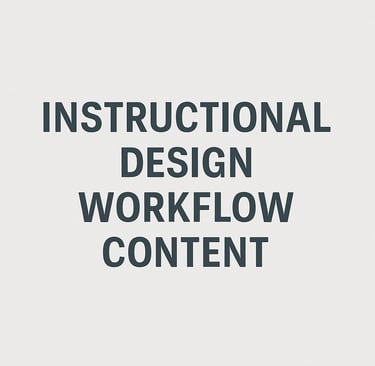
Wk2: Kirkpatrick Level 1 Survey
1. Introduction to the Survey
Keep it welcoming and concise: Briefly thank the participant for taking the time to provide feedback.
Restate purpose: Explain that the survey aims to improve the minicourse by understanding the learner’s experience.
Reinforce confidentiality: Inform learners that their responses are anonymous and will not impact their standing.
Example intro text:
"Thank you for participating in the 'AI Opportunities in Logistics' minicourse. We value your feedback to help improve the course and ensure it meets the needs of professionals in the logistics and supply chain field. This short survey will take just a few minutes and focuses on your overall experience, engagement, and the course’s relevance to your work. All responses are confidential and will only be used for course improvement."
© 2025 SCM Trainer. Licensed under Creative Commons Attribution-NonCommercial 4.0 International (CC BY-NC 4.0). You may share and adapt this content for non-commercial use with proper attribution.
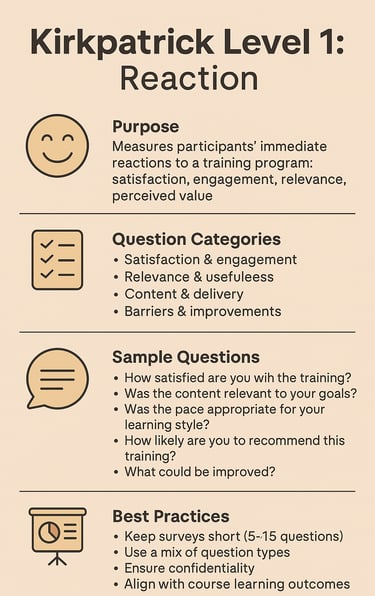

Wk2: Kirkpatrick Level 1 Survey (Continuation)
© 2025 SCM Trainer. Licensed under Creative Commons Attribution-NonCommercial 4.0 International (CC BY-NC 4.0). You may share and adapt this content for non-commercial use with proper attribution.
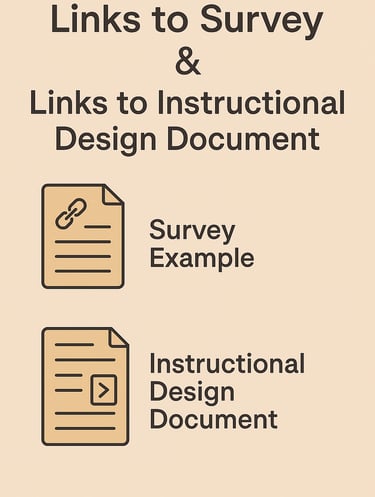

Wk2: Kirkpatrick Level 1 Survey (Continuation)
My experience creating a Level 1 survey
Creating the Level 1 survey for the “AI Opportunities in Logistics” minicourse enabled me to think critically about aligning learner feedback with course learning outcomes and module content. The process helped me design questions that not only assess satisfaction and engagement but also provide insights into perceived relevance, pacing, and content clarity.
In the past, when working through a training company, Level 1 evaluations were typically limited to “smile sheets” or end-of-course feedback focused mainly on whether the attendee enjoyed the course and intended to apply the new knowledge at work. However, no follow-up was conducted with the professional or organization to confirm whether the learning was used, making us, in effect, little more than order takers.
In contrast, this thoughtfully designed survey provides actionable feedback that can be used to improve instructional quality, increase learner impact, and contribute to a culture of continuous improvement grounded in real outcomes.
© 2025 SCM Trainer. Licensed under Creative Commons Attribution-NonCommercial 4.0 International (CC BY-NC 4.0). You may share and adapt this content for non-commercial use with proper attribution.
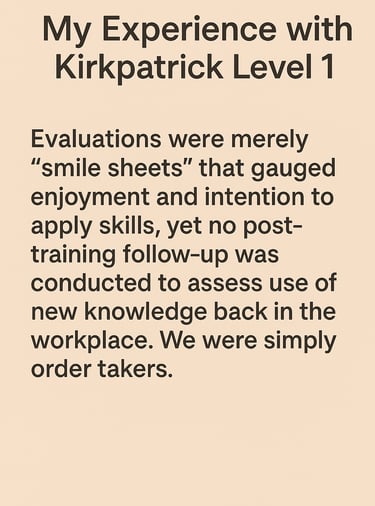

Wk3: Kirkpatrick Level II Assessments
© 2025 SCM Trainer. Licensed under Creative Commons Attribution-NonCommercial 4.0 International (CC BY-NC 4.0). You may share and adapt this content for non-commercial use with proper attribution.
This week we focus on Kirkpatrick Level II: Learning, which measures how well participants have absorbed knowledge, skills, and attitudes from the course.
Provided below are the essential elements and call-outs tied to Module 9 (course summary and course assessment), emphasizing impact measurement, action planning, and readiness for scaling AI in logistics. Use these resources as both reference and practical guides:
eLearning Course – Module 9 Link:
Wk3: Kirkpatrick Level II Assessments (Continuation)
© 2025 SCM Trainer. Licensed under Creative Commons Attribution-NonCommercial 4.0 International (CC BY-NC 4.0). You may share and adapt this content for non-commercial use with proper attribution.
Course Purpose Statement
The purpose of this course is to equip mid-level logistics, warehousing, and transportation professionals with the knowledge and practical skills to identify, evaluate, and implement artificial intelligence (AI) solutions in logistics operations. By blending real-world case studies with readiness tools, this course enables learners to recognize high-impact AI opportunities, assess organizational preparedness, and recommend next steps for piloting and scaling AI applications that deliver measurable operational improvements.
Course Duration and Structure
Course Type: Mini Course (eLearning)
Duration: Approximately 60–90 minutes of interactive content
Structure:
9 Core Modules with scenario-based learning, case studies, and reflection prompts
Knowledge Checks integrated into modules for reinforcement
End-of-Course Assessment (12 questions, must score 12/12 for completion)
Module Breakdown:
Welcome + Learning Objectives
Why AI in Logistics?
AI in Transportation Optimization
Inside the Smart Warehouse
AI for Last-Mile Delivery
Reverse Logistics and Returns
AI Readiness Checklist
Real-World Success Story
Course Wrap-Up & Action Plan
Course-Level Objectives (CLOs)
By the end of this course, learners will be able to:
CO1: Identify high-impact areas within logistics where AI can create operational efficiency.
CO2: Analyze real-world use cases where AI technologies have been successfully implemented.
CO3: Evaluate AI readiness within their own logistics operations.
CO4: Recommend next steps for piloting or scaling AI applications in logistics.
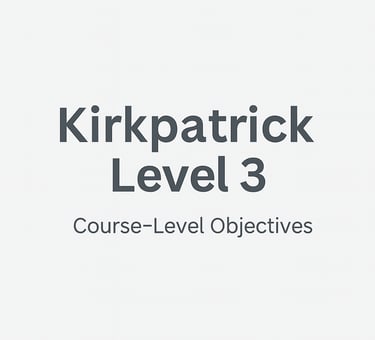

Wk3: Kirkpatrick Level II Assessments (Continuation)
© 2025 SCM Trainer. Licensed under Creative Commons Attribution-NonCommercial 4.0 International (CC BY-NC 4.0). You may share and adapt this content for non-commercial use with proper attribution.
Module 1 – Welcome + Learning Objectives
MO1.1: Describe the overall purpose and scope of AI in logistics (CO1).
MO1.2: Explain how AI impacts different logistics roles (CO1).
MO1.3: Recognize the course objectives and outcomes (CO1, CO2, CO3, CO4).
Module 2 – Why AI in Logistics?
MO2.1: Explain the need for AI to address modern logistics challenges (CO1).
MO2.2: Demonstrate how AI enables real-time decision making (CO1, CO2).
MO2.3: Identify major logistics pain points that AI can solve (CO1).
Module 3 – AI in Transportation Optimization
MO3.1: Explain the role of AI in dynamic routing and fleet optimization (CO1).
MO3.2: Evaluate case studies where AI improved transportation efficiency (CO2).
MO3.3: Assess the cost and service benefits of AI-driven transportation tools (CO1, CO2).
Module 4 – Inside the Smart Warehouse
MO4.1: Describe AI applications in slotting, picking, and inventory accuracy (CO1).
MO4.2: Analyze how robotics and automation transform warehouse operations (CO2).
MO4.3: Evaluate the operational impact of AI-enabled smart warehousing (CO1, CO2)
Module 5 – AI for Last-Mile Delivery
MO5.1: Identify challenges specific to last-mile logistics (CO1).
MO5.2: Explain how AI improves rerouting, ETA accuracy, and customer experience (CO1, CO2).
MO5.3: Evaluate case examples of AI-enabled last-mile solutions (CO2).
Module 6 – Reverse Logistics and Returns
MO6.1: Explain AI’s role in defect detection and return prediction (CO1).
MO6.2: Analyze AI-driven strategies for refurbishment vs. resell optimization (CO2).
MO6.3: Assess the potential of AI to reduce reverse logistics costs (CO1, CO2).
Module 7 – AI Readiness Checklist
MO7.1: Evaluate organizational data infrastructure readiness for AI adoption (CO3).
MO7.2: Prioritize AI use cases based on business value and feasibility (CO3).
MO7.3: Identify workforce skills required for AI readiness (CO3).
Module 8 – Real-World Success Story
MO8.1: Analyze how leading logistics firms successfully implemented AI (CO2).
MO8.2: Compare approaches across Amazon, Walmart, and DHL (CO2).
MO8.3: Draw lessons from real-world implementations to inform future AI adoption (CO2, CO4).
Module 9 – Course Wrap-Up & Action Plan
MO9.1: Measure the potential impact of AI solutions using logistics KPIs (CO4).
MO9.2: Develop an actionable roadmap for piloting AI in logistics operations (CO3, CO4).
MO9.3: Recommend strategies for scaling successful AI pilots across the organization (CO4).
✅ Alignment Summary
CO1: MOs 1.1, 1.2, 2.1, 2.3, 3.1, 3.3, 4.1, 4.3, 5.1, 5.2, 6.1, 6.3
CO2: MOs 1.3, 2.2, 3.2, 3.3, 4.2, 4.3, 5.2, 5.3, 6.2, 6.3, 8.1, 8.2, 8.3
CO3: MOs 1.3, 7.1, 7.2, 7.3, 9.2
CO4: MOs 1.3, 8.3, 9.1, 9.2, 9.3
Every course objective is supported by multiple module objectives, ensuring strong vertical alignment between CLOs and MOs.


Wk3: Kirkpatrick Level II Assessments (Continuation)
© 2025 SCM Trainer. Licensed under Creative Commons Attribution-NonCommercial 4.0 International (CC BY-NC 4.0). You may share and adapt this content for non-commercial use with proper attribution.
Final Knowledge Check – 12 Questions
Q1 – Multiple Choice (CO1)
Question: Which of the following is NOT a logistics challenge AI is designed to address?
A) Driver shortages
B) Sustainability goals
C) Celebrity endorsements
D) Real-time routing complexity
Correct Answer: C) Celebrity endorsements
A) Driver shortages – Incorrect. AI helps optimize fleet operations and labor efficiency to offset driver shortages.
B) Sustainability goals – Incorrect. AI supports emissions tracking and greener routing.
C) Celebrity endorsements – Correct. This has nothing to do with logistics or AI applications.
D) Real-time routing complexity – Incorrect. Dynamic routing is one of AI’s core strengths.
Q2 – Multiple Choice (CO2)
Question: UPS’s ORION system is an example of AI improving logistics by:
A) Predicting customer demand
B) Optimizing driver routes
C) Automating customs clearance
D) Managing warehouse robotics
Correct Answer: B) Optimizing driver routes
A) Predicting customer demand – Incorrect. That’s forecasting, not routing.
B) Optimizing driver routes – Correct. ORION reduces miles driven and fuel use.
C) Automating customs clearance – Incorrect. That’s not ORION’s function.
D) Managing warehouse robotics – Incorrect. ORION is focused on transportation, not warehousing.
Q3 – True/False (CO1, CO2)
Question: AI vision systems in warehouses can improve picking accuracy by identifying incorrect items before they are shipped.
Correct Answer: True
True – Correct. AI vision validates picks, preventing costly mis-shipments.
False – Incorrect. This ignores AI’s proven role in warehouse accuracy.
Q4 – True/False (CO1, CO2)
Question: AI cannot predict which products are most likely to be returned.
Correct Answer: False
True – Incorrect. AI models forecast return-prone SKUs using past data.
False – Correct. AI does help predict high-return products.
Q5 – Drag-and-Drop (CO3)
Question: Match each readiness factor with its description.
Evaluating Data Infrastructure → Ensuring systems can handle and store AI-driven data.
Prioritizing AI Use Cases → Selecting the most impactful and feasible AI applications first.
Building AI-Ready Talent → Upskilling staff to use and maintain AI solutions.
Correct Match: As above.
Incorrect Matches: If mismatched, it shows a misunderstanding of readiness priorities.
Q6 – Drag-and-Drop (CO2)
Question: Match the company with its AI application.
Amazon → Robotics for warehousing productivity
Walmart → AI-driven demand forecasts
DHL → AI for shipment and customs optimization
Correct Match: As above.
Incorrect Matches: Swapping them misrepresents each company’s AI initiatives.
Q7 – Scenario, Multiple Response (CO1, CO2)
Scenario: A customer isn’t home. Which TWO actions are most effective?
A) Reschedule delivery automatically
B) Reroute package to a smart locker nearby
C) Hold package indefinitely until customer calls
D) Deliver package to random nearby address
Correct Answer: A and B
A – Correct. Rescheduling reduces failed deliveries.
B – Correct. Smart lockers improve convenience and security.
C – Incorrect. Indefinite holds delay service.
D – Incorrect. Delivering to a random address breaks trust and service quality.
Q8 – Scenario, Multiple Response (CO3, CO4)
Scenario: Your company wants to pilot AI in logistics. Which TWO steps make sense?
A) Select one high-impact use case
B) Train a cross-functional team
C) Apply AI across all functions immediately
D) Skip measurement and assume benefits
Correct Answer: A and B
A – Correct. Starting small allows for manageable risk and proof of concept.
B – Correct. Training ensures adoption and proper use.
C – Incorrect. Broad implementation without testing risks failure.
D – Incorrect. Skipping measurement prevents proving ROI.
Q9 – Multiple Choice (CO1)
Question: Which logistics role benefits most from AI-driven routing systems?
A) Procurement specialist
B) Transportation manager
C) Quality manager
D) HR coordinator
Correct Answer: B) Transportation manager
A – Incorrect. Procurement doesn’t manage routes.
B – Correct. Routing optimization is central to transportation management.
C – Incorrect. Quality managers focus on standards, not routing.
D – Incorrect. HR has no involvement in route planning.
Q10 – Multiple Choice (CO4)
Question: Which KPI is least relevant when measuring AI’s impact in logistics?
A) On-time delivery rate
B) Carbon emissions per shipment
C) Customer satisfaction scores
D) Employee dress code compliance
Correct Answer: D) Employee dress code compliance
A – Incorrect. On-time delivery is critical.
B – Incorrect. Emissions are a sustainability measure.
C – Incorrect. Customer satisfaction is a service KPI.
D – Correct. Dress codes don’t measure logistics performance.
Q11 – True/False (CO3)
Question: An organization can implement AI successfully without first evaluating its data infrastructure.
Correct Answer: False
True – Incorrect. Data readiness is essential before AI adoption.
False – Correct. Strong data infrastructure is required for effective AI.
Q12 – Scenario, Multiple Choice (CO4)
Scenario: Your pilot AI project reduced delivery costs by 12%. What should be your next step?
A) Scale immediately
B) Measure ROI and gather stakeholder feedback before scaling
C) Abandon the pilot and try a new use case
D) Skip ROI tracking and move straight to automation
Correct Answer: B) Measure ROI and gather stakeholder feedback before scaling
A – Incorrect. Scaling too fast risks failure without validation.
B – Correct. ROI proof and stakeholder buy-in are critical.
C – Incorrect. Abandoning after success ignores the value created.
D – Incorrect. Skipping ROI tracking prevents strategic scaling.


Wk3: Kirkpatrick Level II Assessments (Continuation)
© 2025 SCM Trainer. Licensed under Creative Commons Attribution-NonCommercial 4.0 International (CC BY-NC 4.0). You may share and adapt this content for non-commercial use with proper attribution.
Narrative Alignment of Questions with Bloom's Taxonomy
The 12 end-of-course assessment questions for Opportunities for AI in Logistics are intentionally designed to span multiple levels of Bloom’s Taxonomy, ensuring learners are tested on both foundational knowledge and higher-order decision-making skills.
Remembering (Q3, Q11) – Two questions check for factual recall. For example, learners are asked to recall the role of AI vision systems in warehouse accuracy (Q3) and the necessity of evaluating data infrastructure before adopting AI (Q11). These reinforce critical baseline knowledge.
Understanding (Q1, Q4, Q9) – Three questions test comprehension. Learners must distinguish between real logistics challenges and irrelevant ones (Q1), interpret AI’s predictive role in returns (Q4), and identify which logistics roles most benefit from routing AI (Q9). These ensure learners grasp meaning and context, not just facts.
Applying (Q2, Q6) – Two questions require learners to apply their knowledge of AI to real-world cases. They identify how UPS’s ORION system improved operations (Q2) and match major companies like Amazon, Walmart, and DHL with their respective AI applications (Q6). This validates the learner’s ability to transfer learning to practice.
Analyzing (Q5, Q10) – Two questions demand deeper analysis. Learners analyze readiness factors and correctly match them to organizational needs (Q5), and they evaluate KPI relevance by determining which measures are useful or irrelevant for AI impact assessment (Q10). This develops critical thinking around business priorities.
Evaluating (Q7, Q8, Q12) – Three scenario-based questions push learners into evaluative judgment. They must select the most effective AI-driven last-mile delivery responses (Q7), recommend best practices for piloting AI initiatives (Q8), and determine the correct next step after a successful pilot (Q12). These align with real-world decision-making expected of mid-level professionals.
Creating (N/A) – The current assessment does not include a question at the Create level. While learners are not asked to generate new AI strategies or roadmaps in this exam, the course encourages application of knowledge to their organizations through reflection prompts and action-planning activities in Module 9.


Wk3: Kirkpatrick Level II Assessments (Continuation)
© 2025 SCM Trainer. Licensed under Creative Commons Attribution-NonCommercial 4.0 International (CC BY-NC 4.0). You may share and adapt this content for non-commercial use with proper attribution.
Reflective Narration on Developing Level 2 Assessments
When developing the Level 2 assessments for Opportunities for AI in Logistics, my focus was on ensuring learners went beyond recall to demonstrate comprehension, application, and judgment. Kirkpatrick’s Level 2 emphasizes whether learning has truly occurred, so each question was mapped directly to a course-level objective (CLO) to maintain alignment.
I used Bloom’s Taxonomy as a guide: lower-level questions addressed remembering and understanding (e.g., AI vision systems), mid-level questions applied and analyzed concepts (e.g., matching AI use cases, evaluating KPIs), and higher-level questions evaluated scenarios (e.g., piloting and scaling AI). This balance ensured learners were tested across multiple cognitive levels.
To reinforce mastery, I set the bar high: learners must score 12/12 (100%). With three attempts per question and detailed rationales, the assessment doubles as a learning tool, turning mistakes into opportunities for growth.
Variety was also important. I included four question types — multiple choice, true/false, drag-and-drop, and scenario-based — to mirror real-world decision-making. Scenario items were especially valuable in testing operational judgment, bridging theory and practice.
Ultimately, these assessments are not just checkpoints; they are teaching moments. Each question builds confidence that learners can make precise, informed decisions about AI in logistics.


Wk4: Developing Discussion & Assignment Prompts
© 2025 SCM Trainer. Licensed under Creative Commons Attribution-NonCommercial 4.0 International (CC BY-NC 4.0). You may share and adapt this content for non-commercial use with proper attribution.
Week 4: Discussion & Assignment Prompts
Selected Module/Lesson
Course Title: Opportunities for AI in Logistics
Chosen Module: Module 9 – Course Wrap-Up & Action Plan
Course Learning Outcomes (CLOs) Aligned
CO1: Identify high-impact areas within logistics where AI can create operational efficiency.
CO2: Analyze real-world use cases where AI technologies have been successfully implemented.
CO3: Evaluate AI readiness within their own logistics operations.
CO4: Recommend next steps for piloting or scaling AI applications in logistics.
Module/Lesson Learning Objectives (MOs) Aligned
MO9.1: Measure the potential impact of AI solutions using logistics KPIs (CO4).
MO9.2: Develop an actionable roadmap for piloting AI in logistics operations (CO3, CO4).
MO9.3: Recommend strategies for scaling successful AI pilots across the organization (CO4).
Learning Materials and Activities
Learners will review a case-based scenario illustrating an AI-enabled warehouse and transportation operation.
Interactive dashboard simulation to explore logistics KPIs before and after AI adoption.
A reflection activity where learners create a draft AI roadmap for their own organization.
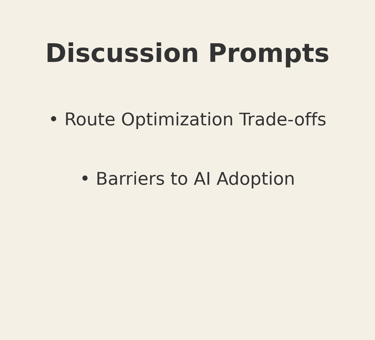

Wk4: Developing Discussion & Assignment Prompts
© 2025 SCM Trainer. Licensed under Creative Commons Attribution-NonCommercial 4.0 International (CC BY-NC 4.0). You may share and adapt this content for non-commercial use with proper attribution.
Discussion 1 – Scaling AI Checkpoints
Prompt: AI initiatives often fail when organizations attempt to scale too quickly. Based on what you’ve learned in Module 9, what are the three most important checkpoints you would include before moving from a pilot project to full implementation? What are the three most important checkpoints before moving from a pilot project to full AI implementation?
Participation Requirements:
Post an initial response (200–250 words) referencing at least one KPI or readiness factor.
Reply to two peers with constructive feedback, suggesting additional checkpoints or improvements.
Aligned Objective(s): MO9.2, MO9.3 (CO3, CO4).
Model Answer: (ROI/KPIs, readiness, and stakeholder alignment.)
Before scaling an AI initiative in logistics, I would focus on three checkpoints:
Validated ROI and KPI performance – The pilot must show measurable improvements in at least two KPIs, including reduced delivery times or improved order accuracy. Without evidence of success, scaling risks adding cost without value.
Organizational readiness – Scaling requires trained staff, clear governance, and reliable data infrastructure. If the workforce is not equipped or data quality is inconsistent, scaling will amplify those weaknesses.
Stakeholder alignment and buy-in – Leadership and cross-functional teams must agree on the strategy, budget, and expectations. Misalignment often leads to stalled projects or “shadow AI” initiatives competing for resources.
By addressing these checkpoints, scaling becomes less about risk and more about sustainable growth.
Wk4: Developing Discussion & Assignment Prompts
© 2025 SCM Trainer. Licensed under Creative Commons Attribution-NonCommercial 4.0 International (CC BY-NC 4.0). You may share and adapt this content for non-commercial use with proper attribution.
Discussion 2 – Measuring AI with KPIs
Prompt: Measuring AI’s success in logistics requires more than cost savings. Which KPI or set of KPIs would you recommend to your leadership team as evidence of AI’s operational impact, and why? Provide examples from the case study or your own workplace. Which KPI(s) would you recommend to leadership as evidence of AI’s operational impact?
Participation Requirements:
Post an initial response (150–200 words) citing at least two KPIs.
Respond to at least two peers, comparing or contrasting KPI choices.
Aligned Objective(s): MO9.1 (CO4).
Model Answer:
For leadership, I would recommend a mix of efficiency, service, and sustainability KPIs:
On-Time Delivery Rate – AI routing and scheduling should show a measurable improvement here.
Order Accuracy – AI-driven vision systems in warehousing reduce mis-picks, directly improving customer experience.
Carbon Emissions per Shipment – With AI recommending greener routes, this KPI connects operational success with sustainability goals.
Together, these KPIs tell a complete story: AI is not only cutting costs but also enhancing service reliability and aligning with ESG commitments..
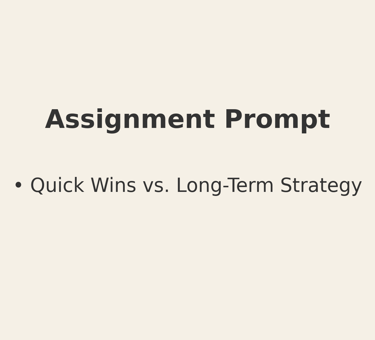

Wk4: Developing Discussion & Assignment Prompts
© 2025 SCM Trainer. Licensed under Creative Commons Attribution-NonCommercial 4.0 International (CC BY-NC 4.0). You may share and adapt this content for non-commercial use with proper attribution.
Assignment – AI Roadmap for Logistics Readiness
Prompt Recap: Develop a two-page roadmap that outlines how your organization (or a sample company provided in the case study) should adopt AI in logistics operations. Include a readiness assessment, pilot project scope, and measurable KPIs for evaluating success. Create a two-page roadmap outlining readiness, pilot, and scaling strategy.
Instructions to Learners:
Include at least three readiness factors from the Module 7 checklist.
Define one pilot project and its success criteria.
Recommend next steps for scaling the pilot if successful.
Submission Guidelines:
Format: PDF or Word (2–3 pages, double-spaced).
Submit via LMS assignment tool.
Due: One week from posting.
Aligned Objective(s): MO9.2, MO9.3 (CO3, CO4).
Model Answer:
Title: AI Roadmap for Logistics Readiness
1. Readiness Assessment
Data Infrastructure: Current ERP system integrates shipment and inventory data, but real-time traffic data feeds are not yet linked. Priority: upgrade API connections.
Talent and Skills: Operations staff trained in Lean and Six Sigma but lack AI analytics exposure. Priority: introduce targeted training.
Governance: No centralized AI governance framework exists. Priority: assign a cross-functional AI steering committee.
2. Pilot Project
Focus Area: Last-mile delivery optimization.
Scope: 50-vehicle fleet operating in the Northeast region.
KPIs: On-time delivery rate, average delivery cost per package, customer satisfaction scores.
Timeline: 3-month pilot with phased rollout.
3. Scaling Strategy
If Successful:
Roll out optimized routing across the national fleet.
Expand pilot learnings to warehouse slotting AI within 12 months.
Build AI Center of Excellence to support cross-functional adoption.
Next Steps: Continue tracking ROI at quarterly intervals and refine based on KPI trends.
Conclusion:
This roadmap balances ambition with control. By starting with a contained pilot, validating ROI, and addressing readiness gaps, the organization can scale AI with confidence while avoiding common pitfalls.


Wk4: Developing Discussion & Assignment Prompts (Continuation)
© 2025 SCM Trainer. Licensed under Creative Commons Attribution-NonCommercial 4.0 International (CC BY-NC 4.0). You may share and adapt this content for non-commercial use with proper attribution.
Reflection – Week 4 Activity
Teaching Philosophy: The Essential Role of Discussions and Assignments in Learning
As a Master Instructor, I believe that discussions and assignments are not add-ons to the learning process — they are its backbone. Over years of teaching and instructional design, I have seen how these activities transform passive content into active knowledge and lived practice.
Discussions are the heartbeat of collaborative learning. They invite learners to voice perspectives, compare approaches, and test ideas in a safe environment. In my courses, I design discussion prompts that go beyond surface-level recall; they ask learners to apply frameworks, evaluate scenarios, and reflect on their professional experiences. When learners engage in this way, they don’t just consume content — they co-construct meaning. This constructivist approach builds confidence and prepares them to handle ambiguity in real-world logistics operations.
Assignments, on the other hand, are where learners demonstrate individual mastery. They serve as both assessment and rehearsal for workplace performance. In my minicourse, the AI roadmap assignment requires learners to analyze readiness factors, apply course concepts, and recommend a strategy. This mirrors exactly the type of deliverable a logistics professional might present to leadership, making the assignment a bridge between classroom and career.
The interplay between discussions and assignments reflects my teaching philosophy: learning is most powerful when it is active, applied, and authentic. Discussions allow learners to explore and challenge ideas together; assignments compel them to integrate those ideas into coherent outputs that show mastery. Both are essential in moving beyond rote knowledge to higher-order skills like evaluation, decision-making, and strategy development.
I see these activities as directly supporting Kirkpatrick’s Level II and Level III outcomes. Discussions demonstrate that learners have grasped and can debate key concepts (Level II), while assignments simulate on-the-job application (Level III). This alignment ensures that learning does not stop at understanding but translates into measurable workplace performance.
Ultimately, my philosophy is that effective instructional design weaves discussions and assignments into the core of every course. They are not checkpoints or compliance tasks — they are the learning experience itself. As a Master Instructor, I am committed to designing prompts and deliverables that not only measure outcomes but also inspire learners to engage deeply, think critically, and apply confidently in their professional roles.


Wk5: Discussion & Assignment Prompt Rubrics
© 2025 SCM Trainer. Licensed under Creative Commons Attribution-NonCommercial 4.0 International (CC BY-NC 4.0). You may share and adapt this content for non-commercial use with proper attribution.
Copies of Discussion and Assignment Rubics
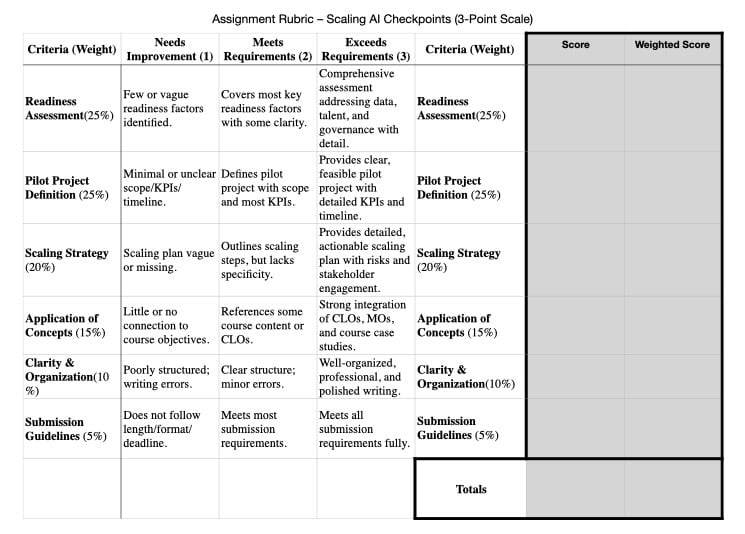



Wk5: Discussion & Assignment Prompt Rubrics
© 2025 SCM Trainer. Licensed under Creative Commons Attribution-NonCommercial 4.0 International (CC BY-NC 4.0). You may share and adapt this content for non-commercial use with proper attribution.
In Week 5, the focus shifted to developing rubrics as essential tools for guiding learning and assessment. As a Master Instructor and instructional designer, I recognize that rubrics are more than grading instruments — they are roadmaps that clarify expectations, support consistency, and provide learners with transparent criteria for success.
This activity required me to design rubrics for both a discussion prompt and an assignment from my minicourse. In doing so, I reflected on how rubrics serve a dual purpose: they help instructors evaluate performance fairly, and they help learners understand what high-quality work looks like. By defining clear criteria, performance levels, and descriptors, rubrics transform assessments into opportunities for growth.
The rubrics I created reinforce my teaching philosophy that assessments should be learning experiences in themselves. They not only measure outcomes but also provide formative guidance, enabling learners to improve continually.
👉 To illustrate flexibility in rubric design, I developed both a 5-point rubric (with detailed performance levels) and a 3-point rubric (with simplified categories). Providing both demonstrates how rubric design can be adapted depending on course needs, level of detail required, and the desired balance between clarity and nuance.


Wk5: Discussion & Assignment Prompt Rubrics (Continuation)
© 2025 SCM Trainer. Licensed under Creative Commons Attribution-NonCommercial 4.0 International (CC BY-NC 4.0). You may share and adapt this content for non-commercial use with proper attribution.
Learner Guidance: How to Use Rubric
Rubrics are designed to help you succeed. They show you exactly what is expected and how your work will be evaluated. Use the rubric as both a planning tool before you start your work and a self-check tool before you submit.
How to Use the Rubric
Review the Criteria – Each row of the rubric highlights the specific skills or knowledge you are expected to demonstrate (e.g., Knowledge of Topic, Critical Thinking, Writing Quality).
Aim for “Exemplary” – The 5-point scale moves from Unsatisfactory (1) to Exemplary (5). Read the descriptors carefully to understand what excellence looks like.
Self-Check Your Work – Before submitting, ask yourself:
Does my response meet the descriptors at the higher levels?
Have I included examples, evidence, or rationale where required?
Does my submission reflect professional clarity and organization?
Learn from Feedback – Your instructor will use the rubric to score your work and provide comments. Compare your score with the rubric descriptors to identify areas of strength and areas to improve.
Engage in Growth – Remember that rubrics are not just for grading. They are tools for learning that show you what mastery looks like and guide you toward improvement in future discussions and assignments.
Tips for Success
For Discussions: Post early, reference course content or real-world examples, and engage meaningfully with peers.
For Assignments: Follow the roadmap provided in the rubric (readiness, pilot, scaling, application). Could you structure your work so it clearly meets each criterion?
By using the rubric as your guide and checklist, you’ll not only meet expectations — you’ll position yourself to exceed them.


Wk5: Discussion & Assignment Prompt Rubrics (Continuation)
© 2025 SCM Trainer. Licensed under Creative Commons Attribution-NonCommercial 4.0 International (CC BY-NC 4.0). You may share and adapt this content for non-commercial use with proper attribution.
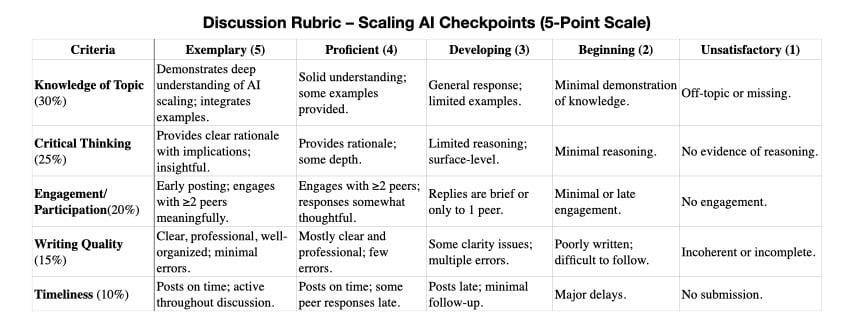

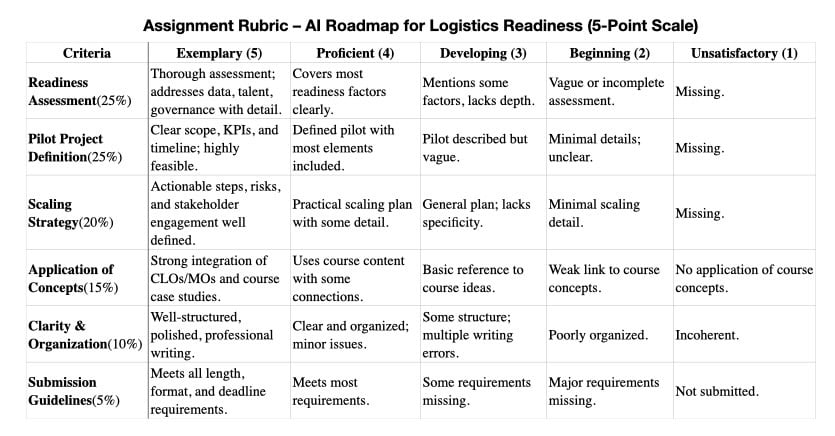

5-Point Rubics Examples
Performance Levels - Scoring Ratings
Exemplary (5): Comprehensive, creative, and strongly aligned with course objectives; integrates real-world insights.
Proficient (4): Clear roadmap with most elements included; generally well-written and practical.
Developing (3): Some missing or vague sections; basic application of concepts.
Beginning (2): Limited effort; fails to meet several key criteria.
Unsatisfactory (1): Off-topic, incomplete, or not submitted.
Wk5: Discussion & Assignment Prompt Rubrics (Continuation)
© 2025 SCM Trainer. Licensed under Creative Commons Attribution-NonCommercial 4.0 International (CC BY-NC 4.0). You may share and adapt this content for non-commercial use with proper attribution.
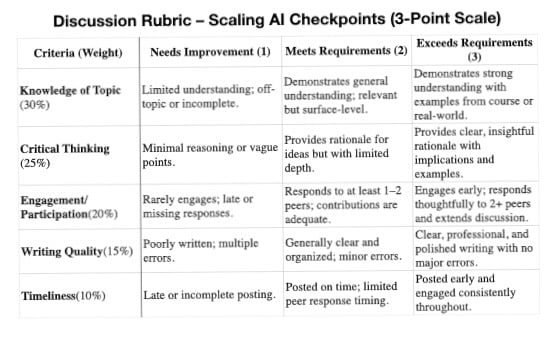


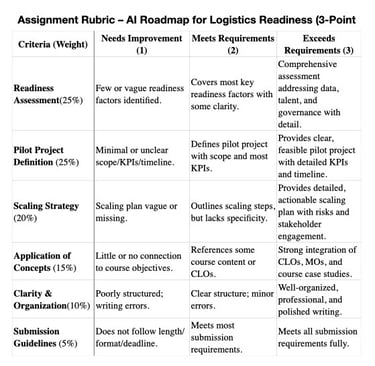
3-Point Rubics Examples
✅ With this structure:
1 = Needs Improvement
2 = Meets Requirements
3 = Exceeds Requirements
It’s easy for learners to understand expectations, and easy for instructors to score consistently.
Wk5: Discussion & Assignment Prompt Rubrics (Continuation)
© 2025 SCM Trainer. Licensed under Creative Commons Attribution-NonCommercial 4.0 International (CC BY-NC 4.0). You may share and adapt this content for non-commercial use with proper attribution.
Week 5: Summary and Reflection
Summary
In Week 5, I focused on the design and application of rubrics as essential tools for assessment. I developed two sets of rubrics — one for a discussion prompt and one for the AI roadmap assignment from my minicourse. To illustrate flexibility, I created both 5-point rubrics, which provide detailed performance distinctions, and 3-point rubrics, which emphasize simplicity and clarity.
Through this process, I reinforced the importance of rubrics in providing learners with transparent expectations, while also giving instructors a structured and consistent method for evaluating performance. The discussion rubric emphasized knowledge, critical thinking, and engagement, while the assignment rubric emphasized readiness assessment, pilot design, scaling strategy, and application of course concepts.
Reflection
As a Master Instructor, I see rubrics as more than grading tools — they are learning guides. Clear descriptors help learners understand what excellence looks like and allow them to self-assess before submission. For instructors, rubrics bring fairness and consistency, ensuring that all learners are evaluated by the same standards.
Creating both 5-point and 3-point rubrics allowed me to compare depth and simplicity in assessment. The 5-point system offers nuance and detailed feedback, while the 3-point system promotes clarity and efficiency. In practice, I would choose based on context: a 5-point rubric for summative assessments where precision matters, and a 3-point rubric for discussions or formative checks where clarity and speed are key.
This week’s work highlighted how rubrics directly support Kirkpatrick Level II evaluation, by making learning expectations explicit and helping learners reflect on their own progress. Moving forward, I will continue to design rubrics that serve as both measuring sticks and roadmaps, ensuring assessments contribute to growth rather than simply compliance.
Wk5: Discussion & Assignment Prompt Rubrics (Continuation)
© 2025 SCM Trainer. Licensed under Creative Commons Attribution-NonCommercial 4.0 International (CC BY-NC 4.0). You may share and adapt this content for non-commercial use with proper attribution.
My Lessons Learned
Studying rubrics this week highlighted how valuable they are—not just for grading but for creating clarity, fairness, and stronger learning experiences. Here are my main lessons learned:
Rubrics serve both sides: They keep grading consistent and aligned with objectives for instructors, while giving learners a clear picture of what’s expected and how performance will be judged.
Format matters: A simple Yes/No checklist works best for short mini courses where efficiency and clarity are the priority.
Nuance in longer courses: A five-point rubric allows me to capture different levels of performance and provide richer feedback in extended programs.
Context drives design: There is no one-size-fits-all rubric; the structure should match the type of course and the depth of learning objectives.
Continuous improvement: Rubrics are both assessment and teaching tools, helping guide learner performance and giving me data to refine future course design.
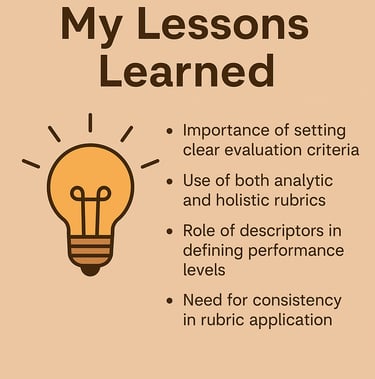

Wk6: Learning Theory/Models & Opening Presentation
© 2025 SCM Trainer. Licensed under Creative Commons Attribution-NonCommercial 4.0 International (CC BY-NC 4.0). You may share and adapt this content for non-commercial use with proper attribution.
Reflection on Learning Theory
In designing my Capstone Mini Course, I found Cognitivism, Constructivism, and Andragogy to be most influential. Cognitivism helped me structure complex AI-in-logistics concepts into smaller, logical sequences supported by visuals and analogies. Constructivism influenced the use of interactive case scenarios where learners test AI-driven routing or inventory optimization decisions, enabling them to build understanding through real-world application. Andragogy ensured each activity was directly connected to professional logistics contexts, emphasizing problem-solving and immediate relevance to the workplace.
Integrating these theories improved the learner experience by making content easier to understand, more relevant, and more engaging. For example, instead of passively reading about predictive analytics, learners forecast delivery delays within a simulation, think about the results, and get personalized feedback. This active approach enhances understanding and helps build confidence to use AI concepts practically.
By basing my design on multiple learning theories, I developed a course that is not only pedagogically solid but also engaging and motivating for busy supply chain professionals.



Wk6: Learning Theory/Models & Opening Presentation (Continuation)
© 2025 SCM Trainer. Licensed under Creative Commons Attribution-NonCommercial 4.0 International (CC BY-NC 4.0). You may share and adapt this content for non-commercial use with proper attribution.
Reflection on Instructional Design Models
While creating my Capstone Mini Course, I mainly followed the ADDIE model, along with parts of Understanding by Design (UbD) and the Successive Approximation Model (SAM). ADDIE gave me a clear framework, starting with a detailed analysis of my target learners—mid-level supply chain professionals—and their operational challenges. The design and development stages helped me organize modules from basic to advanced, making sure each learning goal was matched with relevant activities and assessments. Using Articulate Rise and LearnWorlds for implementation ensured the course was accessible and consistent, while the evaluation phase included knowledge checks, reflection prompts, and a scenario-based final assessment.
UbD strengthened the connection between course objectives and assessments, enabling me to design backward from desired outcomes. SAM complemented this by promoting iterative prototyping of scenarios and interactive elements, allowing me to improve engagement strategies based on early peer and SME feedback.
The benefits of this approach included a structured roadmap that maintained alignment and quality while still offering flexibility to adapt. The main challenge was balancing the rigor of ADDIE with the agility needed for a fast-moving topic like AI in logistics. Nonetheless, the combination of models improved the learning experience by ensuring clarity, relevance, and engagement, ultimately meeting both learner needs and instructional goals.


Wk6: Learning Theory/Models & Opening Presentation (Continuation)
© 2025 SCM Trainer. Licensed under Creative Commons Attribution-NonCommercial 4.0 International (CC BY-NC 4.0). You may share and adapt this content for non-commercial use with proper attribution.
Opening Presentation Screencasts - Storyboard and Link
The opening presentation screencast has been embedded directly into the eLearning course in Session/Module 9: Wrap-Up & Action Plan. This screencast introduces the module, highlights the learning objectives, and sets the tone for the final activities and assessment.
Below, you will find the direct screencast link(s) as well as the Module 9 storyboard, which outlines how the presentation fits into the flow of the course.
Opening Presentation Link:
eLearning course URL link:
IDT400 IDD link (this tab):
Block 1: Opening Presentation Screencast
Block Type: Multimedia – Video with Transcript
On-Screen Text/Visuals: Title card “Module 9: Wrap-Up & Action Plan”; embedded 2–3 minute screencast video with captions.
Narration/Voiceover:
“Welcome to Module 9 of Opportunities for AI in Logistics. In this final module, we’ll bring everything together by focusing on how to measure impact and create a practical roadmap for AI adoption. You’ll review KPIs, explore pilot strategies, and consider how to scale AI across your organization.”Learner Activity/Interaction: Watch video; read transcript.
Instructional Notes: Screencast acts as module orientation. Ensure captions and transcript are provided for accessibility.
Block 2: Module Learning Objectives
Block Type: Text – Statement List
On-Screen Text/Visuals:
MO9.1: Measure the potential impact of AI solutions using logistics KPIs.
MO9.2: Develop an actionable roadmap for piloting AI.
MO9.3: Recommend strategies for scaling successful AI pilots.
Narration/Voiceover:
“By the end of this module, you’ll be able to measure AI’s impact, design a pilot roadmap, and recommend strategies for scaling AI adoption.”Learner Activity/Interaction: Read/listen.
Instructional Notes: Tie back to CO3 and CO4.
Block 3: Dashboard Simulation (Interactive)
Block Type: Interactive Block – Labeled Graphic or Scenario
On-Screen Text/Visuals: Split dashboard showing “Before AI” vs. “After AI” metrics: On-time delivery, cost per shipment, order accuracy, emissions.
Narration/Voiceover:
“Let’s compare a logistics operation before and after AI adoption. Notice the improvements in delivery times, cost per package, and accuracy. AI’s value is measurable.”Learner Activity/Interaction: Clickable dashboard hotspots to reveal KPI definitions and impacts.
Knowledge Check/Reflection: “Which KPI improvement would carry the most weight in convincing your leadership team to expand AI adoption?” (Short answer or multiple-choice).
Instructional Notes: Provide branching feedback: emphasize ROI for cost, ESG for emissions, service quality for accuracy.
Block 4: Case Studies Carousel
Block Type: Carousel or Flip Cards
On-Screen Text/Visuals: Company logos (Amazon, Walmart, DHL) with short case descriptions.
Narration/Voiceover:
Amazon: Robotics improved picking accuracy and reduced fulfillment times.
Walmart: AI-driven forecasting increased demand accuracy.
DHL: AI-driven customs optimization reduced clearance delays.
Learner Activity/Interaction: Flip through carousel/flip cards.
Knowledge Check/Reflection: Matching activity (drag company → AI application).
Instructional Notes: Provide immediate feedback for each match.
Block 5: Action Planning Activity
Block Type: Knowledge Check – Fill-in-the-Blank or Scenario-Based Form
On-Screen Text/Visuals: Action plan template with 3 prompts:
Readiness factors
Pilot project scope
Scaling strategy
Narration/Voiceover:
“Now it’s your turn. Draft a simple AI roadmap for your organization. Identify one readiness factor to strengthen, outline a pilot project, and define how success will be measured.”Learner Activity/Interaction: Learners input responses into a downloadable/exportable worksheet (Rise fill-in block).
Instructional Notes: Encourage learners to save/export as PDF for workplace application.
Block 6: Wrap-Up & Reflection
Block Type: Text + Multimedia (Reflection Prompt)
On-Screen Text/Visuals:
Key takeaways:
AI’s impact can be measured with KPIs.
Pilots are essential before scaling.
Scaling requires readiness and alignment.
Narration/Voiceover:
“As we close, remember: AI adoption is not about chasing hype — it’s about creating measurable value in logistics operations. Start small, measure impact, and scale wisely.”Learner Activity/Interaction: Voice-enabled reflection prompt: “What is one concrete action you will take in your role to begin exploring AI adoption?”
Instructional Notes: Encourage learners to capture reflection in course workbook.
Block 7: Transition to End-of-Course Assessment
Block Type: Text + Button Link
On-Screen Text/Visuals: Instructions for knowledge check:
“You must complete a 12-question assessment.”
“Each question is worth 1 point.”
“You must score 12/12 points (100%) to pass.”
“You have three attempts per question.”
Narration/Voiceover:
“You’re now ready for the final knowledge check. Remember, you need a perfect score to pass, but each question includes feedback to support your learning. If needed, revisit earlier modules before reattempting.”Learner Activity/Interaction: Click button → Launch assessment.
Instructional Notes: Set knowledge check to mastery mode in Rise; enable retries per question.
Wk7: Developing a Syllabus
© 2025 SCM Trainer. Licensed under Creative Commons Attribution-NonCommercial 4.0 International (CC BY-NC 4.0). You may share and adapt this content for non-commercial use with proper attribution.
Minicourse Syllabus – AI Opportunities in Logistics
Opportunities for AI in Logistics
Instructor: Jeffrey McDaniels, APICS Master Instructor & Instructional Designer
Course Description
This 60–90 minute mini eLearning course explores how artificial intelligence (AI) is transforming logistics. Learners will analyze real-world case studies, evaluate organizational readiness, and develop an AI roadmap for operational excellence.
Course Learning Outcomes (CLOs)
By the end of this course, you will be able to:
Identify high-impact AI opportunities in logistics operations.
Analyze case studies of successful AI applications.
Evaluate organizational readiness for AI adoption.
Recommend next steps for piloting and scaling AI.
Course Structure (Modules)
Welcome & Objectives
Why AI in Logistics?
Transportation Optimization
Inside the Smart Warehouse
AI for Last-Mile Delivery
Reverse Logistics & Returns
AI Readiness Checklist
Real-World Success Stories
Wrap-Up & Action Plan
Requirements
Reliable internet & updated browser
Device for accessing LMS modules
PDF reader
Grading & Assessments
Discussions (2 prompts): 30%
Assignment (AI Roadmap): 40%
Knowledge Check (12 Qs, 100% required): 30%
Policies
Late Work: Discussions must be posted on time; assignments accepted up to 48 hours late (10% penalty).
Integrity: Submit original work only. Plagiarism = no credit.
Accessibility: Closed captions & transcripts included. Additional accommodations available on request.
Instructor Contact
📧 Email: jeffrey@scmtrainer.com (Jeffrey B. McDaniels
💻 Office Hours: By appointment via Zoom
✨ SCM Trainer | Empowering Supply Chain Professionals with Actionable Learning
Wk7: Developing a Syllabus
© 2025 SCM Trainer. Licensed under Creative Commons Attribution-NonCommercial 4.0 International (CC BY-NC 4.0). You may share and adapt this content for non-commercial use with proper attribution.
Minicourse Syllabus – AI Opportunities in Logistics
Opportunities for AI in Logistics
Instructor: Jeffrey McDaniels, APICS Master Instructor & Instructional Designer
Course Description - 50-90minutes, mini-eLearning course
Artificial intelligence is no longer a future concept — it’s already transforming logistics operations around the world. This course introduces mid-level logistics, warehousing, and transportation professionals to the opportunities AI creates for efficiency, resilience, and customer satisfaction. Through nine focused modules, you’ll explore real-world case studies, interactive scenarios, and practical tools to:
Identify high-impact AI opportunities across logistics functions.
Analyze examples of successful AI adoption.
Evaluate your organization’s readiness for AI.
Recommend next steps for piloting and scaling solutions.
By the end of the course, you won’t just understand how AI works in logistics — you’ll be equipped to take action, design pilot projects, and guide your team toward measurable improvements in cost, service, and sustainability.
Course Learning Outcomes (CLOs)
By the end of this course, you will be able to:
Identify high-impact AI opportunities in logistics operations.
Analyze case studies of successful AI applications.
Evaluate organizational readiness for AI adoption.
Recommend next steps for piloting and scaling AI.
Course Structure (Modules)
Welcome & Objectives
Why AI in Logistics?
Transportation Optimization
Inside the Smart Warehouse
AI for Last-Mile Delivery
Reverse Logistics & Returns
AI Readiness Checklist
Real-World Success Stories
Wrap-Up & Action Plan
Requirements
Reliable internet & updated browser
Device for accessing LMS modules
PDF reader
Grading & Assessments
Completion of all module knowledge test
End of Course Knowledge Check (12 Qs, 100% required): 100%%
3 changes to select the correct answer before requiring restudy.
Policies
Late Work: Discussions must be posted on time; assignments accepted up to 48 hours late (10% penalty).
Integrity: Submit original work only. Plagiarism = no credit.
Accessibility: Closed captions & transcripts included. Additional accommodations available on request.
Instructor Contact
📧 Email: jeffrey@scmtrainer.com (Jeffrey B. McDaniels
💻 Office Hours: By appointment via email: jeffrey@scmtrainer.com
✨ SCM Trainer | Empowering Supply Chain Professionals with Actionable Learning
Wk8: Evaluating Online Courses & Minicourse Submission
© 2025 SCM Trainer. Licensed under Creative Commons Attribution-NonCommercial 4.0 International (CC BY-NC 4.0). You may share and adapt this content for non-commercial use with proper attribution.
Link to my screencast presentation: https://youtu.be/N0DGss-Y-7Y
Link to my portfolio site: https://www.instructionaldesign.xyz/
Link to the IDD (400x): https://www.instructionaldesign.xyz/documents#idd400-eval--capstone
Link and access information to mini-course: https://360.articulate.com/review/content/963d8ff8-342b-4db8-b3e5-ee87b0b986c7/review
InstructionalDesign.xyz
a division of SCM Trainer
Raleigh, North Carolina, USA
www.instructionaldesign.xyz
jeffrey@scmtrainer.com